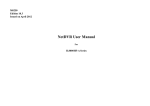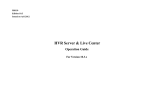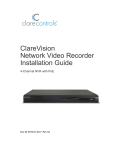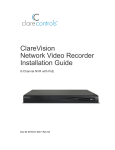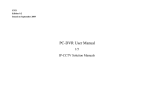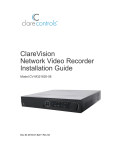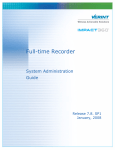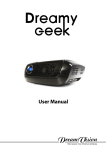Download NetDVR User Manual
Transcript
M0240 Edition 10.3 Issued on March 2012 NetDVR User Manual For IL7100HV-A Series No part of this manual, including the products and software described in it, may be reproduced, transmitted, transcribed, stored in a retrieval system, or translated into any langu VR; or (2) the serial number of the product is defaced or missing. ILDVR PROVIDES THIS MANUAL “AS IS” WITHOUT WARRANTY OF ANY KIND, EITHER EXPRESS OR IMPLIED, INCLUDING BUT NOT LIMITED TO THE IMPLIED WARRANTIES OR CONDITIONS OF MERCHANTABILITY OR FITNESS FOR A PARTICULAR PURPOSE. IN NO EVENT SHALL ILDVR, ITS DIRECTORS, OFFICERS, EMPLOYEES OR AGENTS BE LIABLE FOR ANY INDIRECT, SPECIAL, INCIDENTAL, OR CONSEQUENTIAL DAMAGES (INCLUDING DAMAGES FOR LOSS OF PROFITS, LOSS OF BUSINESS, LOSS OF USE OR DATA, INTERRUPTION OF BUSINESS AND THE LIKE), EVEN IF ILDVR HAS BEEN ADVISED OR THE POSSIBILITY OF SUCH DAMAGES ARISING FROM ANY DEFECT OR ERROR IN THIS MANUAL OR PRODUCT. SPECIFICATIONS AND INFORMATION CONTAINED IN THIS MANUAL ARE FURNISHED FOR INFORMATIONAL USE ONLY, AND ARE SUBJECT TO CHANGE AT ANY TIME WITHOUT NOTICE, AND SHOULD NOT BE CONSTRUED AS A COMMITMENT BY ILDVR. INACCURACIES THAT MAY APPEAR IN THIS MANUAL, INCLUDING THE PRODUCTS AND SOFTWARE DESCRIBED IN IT. Products and corporate names appearing in this manual may or may not be registered trademarks or copyrights of their respective companies, and are used only for identification or explanation and to the owners’ benefit, without intent to infringe. Copyright © 2012 ILDVR DIGITAL TECHNOLOGY USA INC all rights reserved. To contact us: Headquarter: www.ildvr.com Branches Europe: www.ildvr.eu Russia: www.ildvrcom.ru, China: www.ildvr.net ILDVR Global Distribution & Service Danmark: www.ildvr.dk Germany: www.ildvr.de Hungary www.ildvr.hu Italy: www.ildvr.it Netherland: www.ildvr.nl Russia: www.il-dvr.ru www.ildvr-video.ru Ukraine: www.ildvr.com.ua USA: www.ildvr-usa.com Tech-support: [email protected] Directory Introduction…………………………………………………………………………………………………………………………………..………7 1 Product Features and Specifications ………………………………….……………………………….………………………………….…………9 1.1 1.2 1.3 1.4 2 2.1 2.2 3 3.1 3.2 3.3 4 4.1 4.2 4.3 4.4 5 5.1 5.2 5.3 Compression…………………………………………………………………………………….…………………………………………….….………..9 Local Function………………………………………………………………………………………………………………………………..….…………9 Network…………………………………………………………………………..……………….……………………………………..…………………10 Specification……………………………………………………………………………………………………………………………..…………………11 Installation………………………………….……………………………….…………………………………………………………………………….12 Rear Panel Description…………………………………………………………………………………………………………………….……………………12 External Alarm In/Out Connection…………………………………………………………………………………………………….…………..……………14 Front Panel and Remote Controller Introduction………………………………….…………………………………………………….………..15 NetDVR Front Panel…………………………………………………………………………………….…………………………………………………15 IR Remote Controller…………………………………………………………………………..……………………………………….…………………20 Using USB Mouse………………………………………………………………..…………………………………………...……………….…………………21 Basic Operation………………………………….……………………………….………………………………………………….………………….22 Power on and shut down……………………………………………………………………………………………….………………….…………………….22 User Name and Password…………………………………………………………………………………………………………….……..…………………..23 Running Setup Winzard……………………………………………………………………………………………………………….……..…………………..23 Set Date and Time…….………………………………………………………………………………………….…………………..…………………………26 Live Video Preview Operation………………………………….…………………………………………………………..………..…………….………..26 Mouse Operation in Live Preview…………………………………………………………………………………………………………..………………….27 Configure Live Preview Display.……..……………………………………………………………………………………………………..…………………27 Set Camera Order……………………………………………………………………………………………………….………………………………..…….28 Record Setup……………………………………………………………………………………………………….……………………………………………29 6 6.1 6.2 6.3 Initializing Record Settings……………………………………………………………………………………….……………………………………………29 Scheduling a Recording……………………………………………………………………………………….………………….………………………………………30 Starting a Manual Recording……………………………………………………………………………………….……………………….……………………………31 6.4 6.5 Lock/Unlock a Recorded File……………………………………………………………………………………….……………………………………………………31 Set HDD to Read Only……………………………………………………………………………………….…………………………………..………………………31 ____________________________________________________________________________________________________________________________________________________________ NetDVR User Manual 4 / 97 Playback………………………………………………………………………………….……………………………………………………………….……………33 7 7.1 Playback by Search……………………………………………………………………………………….………………………………………………………………33 7.2 7.3 7.4 Playback in Live Preview Mode……………………………………………………………………………………….……….………………………………………34 Playback by System Log……………………………………………………………………………………….…………………….…………………………………34 Playback Frame-by-Frame………………………………………………………………………………………………...……………………………………………35 7.5 Digital Zoom……………………………………………………………………………………….……………………………………………………………………35 8 8.1 Backup………………………………………………………………………………………………………………………………….………………………………35 Export Files………………………………………………………………………………….……………………………………………………..…………….………35 8.2 8.3 Export Video Clip…………………………………………………………………………………….……………………………………………………..……………37 Manage Backup Devices………………………………………………………………………………….……………………………………….……………………38 9 9.1 9.2 9.3 Alarm Setup……………………………………………………………………………………….………………………………………………..…………………38 Motion Detection Alarm………………………………………………………………………………….……………………………………………..……….………38 Sensor Alarm Settings………………………………………………………………………………….………………………………………………..…..……..……40 Manual Alarm Trigger………………………………………………………………………………….………………………………………………..…….…..……43 9.4 9.5 9.6 Video Loss Detection………………………………………………………………………………….…………………………………………………..…….………43 Video Tamper Detection…………………………………………………………………………………….……………………………………………………………44 Exception Settings…………………………………………………………………………………….………………………………………………………….………45 9.7 Understand Exception Trigger Options…………………….………..……………………………………………………….…………………………….……………46 Network Settings……………………………………………………………………………………….……………………..……………………………………47 10 10.1 Configure General Settings……………………………………………………………………………………………….……………………………………………47 10.2 10.3 10.4 PPPoE Settings……………………………………………………………………………………………………….…….……………………………………………48 Configure DDNS……………………………………………………………………………………………..…………….……………………………………………48 NTP Server Settings…………………………………………………………………………………………..…………….……………………………………………49 10.5 10.6 10.7 Remote Alarm Host Settings………………………………………………………….…………………………………….……………………………………………50 Configure Multicast…………………………………………………………………………………………………….……………………………………………50 Configure Server and HTTP Ports………………………………………………………..……………………………….……………………………………………51 11 11.1 11.2 PTZ Control……………………………………………………………………………………….…………………………………………………………………52 Configure PTZ Settings……………………………………………………………………………….…………………….……………………………………………52 Understand PTZ Control………………………………………………………..………………………………………….……………………………………………53 11.3 11.4 Customize Presets………………………………………………………….……………………………………………….……………………………………………53 Customize Patrols…………………………………..………..…………………………………………………………….……………………………………………54 ____________________________________________________________________________________________________________________________________________________________ NetDVR User Manual 5 / 97 11.5 Customize Patterns…………………………………………..…………………………………………………………….……………………………………………55 12 12.1 12.2 12.3 Camera Management………………………………………………………………………………………………….……………………………………………55 OSD Settings…………………………………………………………………………………………….………………….……………………………………………55 Display Settings………………………………………………………………………………………………………….……………………………………………56 Privacy Mask Settings…………………………………………….……………………………………………………….……………………………………………56 HDD Management………………………………………………………………………………………………….……………………………………………57 13 13.1 13.2 Initializing HDD…………………………………………………………………………………………………….……………………………………………57 Set HDD Group………………………………..…………….……………………………………………………….……………………………………………57 13.3 13.4 13.5 Set HDD Status……………………………..……………….……………………………………………………….……………………………………………58 Configure HDD Alarm…………………………….…….……………………………………………………………….……………………………………………61 HDD Calculation Chart…………………………………….……………………………………………………………….……………………………………………61 14 14.1 14.2 DVR Management………………………………………………………………………..…………………………….……………………………………………61 Configure General Settings…………………………………………………………………………………………..…….……………………………………………61 Configure Advance Settings……………….……………………………………………………………………………….……………………………………………62 14.3 14.4 14.5 RS-232 Port Settings……………………….……………………………………………………………………………….……………………………………………63 Manage User Accounts…………………………..………………………………………………………………………….……………………………………………64 Manage System……………………………………………………………………………………………………….……………………………………………67 15 16 17 IE Web Client…………………………………………………………………………………….….………………………………………………………………70 Search and Modify IP Address……………………………………………………………………………………….…………………………………………73 Connect to HVR Server and Live Center ………………………….………………………….……………………………….……………………………74 Remote Management From HVR Server and Live Center………………………………...……………………………………………………….………76 Network Redundancy Record……………………………………………………………………………….……………………………………………….78 18 19 19.1 Continuous Record Setup……………………………………………………………………………….………………………………………………………..…78 19.2 19.3 Motion Detect Alarm Record Setup……………………………………………………………………………….………………………………………………..78 Sensor Trigger Alarm Record Setup……………………………………………………………………………….………………………………………………..80 20 Remote PTZ Operation…………………………..……………………………………………………….…………………………………………………….82 Display on TV-wall……………………………………………………………………………….………………………………………………………………….85 Audio Chat……………………………………………………………………………….……………………………………………………………………………86 Manually Trigger Alarm out ……………………………………………..………………………………….……………………………………………………86 21 22 23 Appendix IKB-2888 keyboard Operation…………………………..………………………………….……………………………………………………87 ____________________________________________________________________________________________________________________________________________________________ NetDVR User Manual 6 / 97 Introduction of IP-CCTV Solutions Thank you for choosing this product for your security video surveillance system. This operation manual illustrates how to set up hardware and software explains each individual icon function and demonstrates how to use the system effectively in a stable environment. Prior to install/utilize the system, operators should go through this manual thoroughly. Local suppliers may support them in due course. IP-CCTV Product Lines Item Product Name Video Record Type Why use it? 1 iHVR (Hybrid DVR) Local HDD High resolution, high quality, friendly GUI interface, convenient operation, easy to expand cameras, powerful integration ability. 2 NetDVR (Stand Alone) Local HDD Stable, no risk of computer virus, easy maintenance 3 IP Camera Local SD card and network Next generation product, all in one combo, easy installation, the best video quality. 4 IP Speed Dome Network stream Has all traditional high speed dome features but overcome the coaxial cable distant limit 5 IP Video Server Network stream (5001HS both SD card and network) Convert existing analog camera to IP camera, directly upgrade to IP video surveillance system 6 IP Matrix/TV-out (Decode card) N/A Utilize existing TV-wall facility _____________________________________________________________________________________________________________________________________________________________ NetDVR User Manual 7 / 97 _____________________________________________________________________________________________________________________________________________________________ NetDVR User Manual 8 / 97 1 Product Features and Specifications 1.1 • • • • • • • 1.2 Compression H.264 hardware compression. Support up to 16 channels video input (PAL/NTSC). Each channel is independent and real time (PAL: 25 FPS, NTSC: 30FPS). Support both variable bit rate and variable frame rate. OggVorbis audio compression standard. Independent video encoding parameters, including frame rate, resolution, bit rate, video quality, etc. Scheduled and event recording parameters configurable for per individual camera. Support dual stream. Encoding for both audio/video composite stream and video stream; audio and video synchronization during composite stream encoding. Compression, storage and network transmission of video image at 4CIF or CIF resolution. Local Function Record • • • • • • • • • • • Cycle and non-cycle recording mode. Scheduled and event video encoding parameters. Multiple recording types, including manual, continuous, alarm, motion, motion | alarm and motion & alarm recording, etc. 8 recording time periods with separate recording types. Pre-record and Post-record time for alarm and motion detection, and pre-record time for schedule and manual recording. Lock and unlock of video files. HDD property can be set to read-only. Video data search and playback by channel number, recording type, time etc. Digital zoom function in playback mode. Pause, play fast, play slow, skip forward, and skip backward when playback, locating in progress bar by dragging the mouse. Up to 4/8/16-channel synchronous playback. Local Monitoring • • • • • • • • • Up to 1024×768 resolution for VGA output display. Simultaneous VGA and CVBS output. 1/4/9/16-camera video live view, with the camera order adjustable. Group switch, manual switch and automatic cycle modes selectable for video live view, with the auto cycle period configurable. Digital zoom in live view mode. Shield of assigned channel for live view. Privacy masking capability. Multiple PTZ protocols supported, and settings and call up of presets, patrols and patterns. Video image zoom-in by clicking the mouse and tracing by dragging mouse in PTZ control mode. Alarm & Exception _____________________________________________________________________________________________________________________________________________________________ NetDVR User Manual 9 / 97 • • • • Configurable arming time for alarm in/out. Various alarm types supported: alarms for video loss, motion detection, video tempering, video in/out format unmatched, illegal access, network disconnection, IP conflict, hard disk error and hard disk full. Various alarm response actions supported: camera recording, relay out, on-screen warning, audible warning and upload to center, etc. Auto recovery from exceptions. Backup • • • • Record files backed up via USB or SATA device. Bunch backup by file or by time. Record files edited for backup in playback. Management and maintenance for backup devices. PTZ • • Support many kinds of PTZ protocol. Support preset, sequence and tour. Alarms • • Support Email Alarm Notification Support exception alarm, motion detection alarm, external alarm, etc. Others • • • • 1.3 • • • • • • • • Control of DVR via front panel keys, mouse, and IR remote control. Three-level user management, each user with individual operating permission for DVR and camera. Powerful record and search for log of operation, alarm and exceptions. Import/export of device configuration files. Network 10/100M adaptive network interface. TCP/IP protocol suites, PPPoE, DHCP, DNS, DDNS, NTP, SADP protocols, etc. Unicast and multicast supported; TCP and UDP protocols applicable in unicast transmission. Remote search, playback and download, lock/unlock of video files. Support breakpoint resume. Remote access and configuration of parameters; remote import/export of device configuration parameters. Remote access of device running status, system log and alarm status. Remote control of DVR via button operation. _____________________________________________________________________________________________________________________________________________________________ NetDVR User Manual 10 / 97 • • • • • • • • • Remote lock/unlock of panel buttons and mouse. Remote formatting of hard disk, upgrade, reboot/shutdown and other system maintenance operations. RS-232 and RS -485 transparent channel transmission. Event alarm and exceptions upload to remote management host. Remote manual recording. Remote video image capture in JPEG format. Remote PTZ control. Voice talk and broadcast. Built-in Web Server. 1.4 Specification Model Video/Audio input Video compression Analog video input Video interface IL7104HV-A IL7108HV-A H.264 4-ch 8-ch BNC connector (1.0 Vp-p, 75 Ω); PAL / NTSC adaptive Audio compression G.711 Audio input 1-ch,RCA connector (2.0 Vp-p, 1 KΩ) Voice talk input 1-ch, RCA (2.0 Vp-p, 1 KΩ) VGA output 1-ch, resolution: 1280 × 1024 / 60 Hz, 1024 × 768 / 60 Hz CVBS output Audio output Recording Resolution Frame rate Video/Audio output Hard disk IL7116HV-A 16-ch 1-ch,RCA connector (2.0 Vp-p, 1 KΩ) 4-ch,RCA connector (2.0 Vp-p, 1 KΩ) 2-ch, BNC connector (1.0 Vp-p, 75 Ω); Resolution: PAL: 704 × 576, NTSC: 704 × 480 1-ch, RCA connector (Linear, 1 KΩ) 4CIF/2CIF/CIF Main stream: Main stream: Main stream: 4CIF / 2CIF@12 fps, CIF@25fps (P)/30 fps(N) 4CIF / 2CIF@8 fps, CIF@25 fps (P) /30fps (N) 4CIF / 2CIF@6 fps, CIF@25 fps (P) / 30fps (N) Sub stream: Sub stream: Sub stream: CIF / QCIF@ up to 25 fps (P) / 30 fps (N) CIF / QCIF@ up 25 fps (P) / 30 fps (N) Video bit rate 32 kbps ~ 2048 kbps, or user-defined (Max. 3072 kbps) Stream type Video/ Video & Audio Audio bit rate 64 kbps Dual stream Support Synchronous playback 4-ch Type Capacity Network interface 1 SATA interface 1 SATA interface Up to 2TB capacity for each interface 1, RJ45 10 M / 100 M adaptive Ethernet interface 8-ch to CIF / QCIF@ up to 25 fps (P) / 30 fps (N) 16-ch 2 SATA interfaces _____________________________________________________________________________________________________________________________________________________________ NetDVR User Manual 11 / 97 External interface Serial interface USB interface Alarm in Alarm out Power supply Consumption Others 1 RS-485 interface, 1 RS-232 interface (IL7116HV-A only) 2, USB 2.0 4 4 1 1 12 VDC ≤10 W (without hard ≤10 W (without hard disk or DVD-R/W) disk or DVD-R/W) 16 4 ≤15 W (without hard disk or DVD-R/W) Working temperature -10 ºC ~ +55 ºC Working humidity 10% ~ 90% Chassis Stand-alone 1U chassis Stand-alone 1U chassis 19-inch rack-mounted 1.5U chassis Dimensions (W × D × H) 315 × 230 × 45 mm 315 × 230 × 45 mm 445 × 390 × 70 mm ≤2 kg (without hard disk or DVD-R/W) ≤2 kg (without DVD-R/W) Weight hard disk or ≤4 kg (without DVD-R/W) hard disk or 2 Installation In order to run NetDVR stably, please install the NetDVR in well ventilation space with allowed range of temperature and humidity as claimed in specifications. 2.1 Rear Panel Description IL7104HV-A/7108HV-A Rear Panel (Please refer to real product for different model) No. Item Description _____________________________________________________________________________________________________________________________________________________________ NetDVR User Manual 12 / 97 1 VIDEO IN BNC connectors for analog video input 2 VIDEO OUT VIDEO OUT1 is main video out 3 AUDIO IN RCA connectors for analog audio input 4 AUDIO OUT RCA connector for audio output 5 VGA DB15 connector for VGA output. Display local video output and menu 6 LAN Connector for LAN (Local Area Network) 7 USB Connector for USB devices 8 RS-485 Interface Connector for RS-485 devices. T+, T- pin connects to PTZ 9 ALARM IN Connector for alarm input ALARM OUT Connector for alarm output 10 POWER Switch for turn on/off the device 11 12V 12VDC power supply 12 GND (needs to be connected when DVR starts up) IL7116HV-A Rear Panel (Please refer to real product for different model) No. Item Description 1 MAIN VIDEO OUT BNC connectors for main video out _____________________________________________________________________________________________________________________________________________________________ NetDVR User Manual 13 / 97 SPOT VIDEO OUT BNC connectors for spot video out 2 VIDEO IN BNC connectors for analog video input 3 AUDIO IN RCA connectors for analog audio input 4 LINE IN RCA connector for audio input (Remote Chat) 5 AUDIO OUT RCA connector for audio output 6 VGA DB15 connector for VGA output. Display local video output and menu 7 RS-232 Interface DB9 connector for RS-232 devices. 8 LAN Connector for LAN (Local Area Network) 9 USB Connector for USB devices 10 RS-485 Interface Connector for RS-485 devices. T+, T- pin connects to PTZ 11 ALARM IN Connector for alarm input ALARM OUT Connector for alarm output 12 12V 12VDC power supply 13 POWER Switch for turn on/off the device 14 GND Ground(needs to be connected when DVR starts up) 2.2 External Alarm In/Out Connection The alarm input is a Normal Open/Closed relay. If the input is not a Normal Open/Closed relay, follow the connection diagram below: Figure 2.2.1 _____________________________________________________________________________________________________________________________________________________________ NetDVR User Manual 14 / 97 To connect to an AC/DC load, use the following diagram: Figure 2.2.2 For DC load, JP4 can be used within the limit of 12V/1A safely. If the interface is connected to an AC load, JP4 should be left open. Use an external relay for safety (as shown in the figure above). There are 4 jumpers (JP4, JP5, JP6, and JP7) on the motherboard, each corresponding with one alarm output. By default, jumpers are connected. To connect an AC load, jumpers should be removed. For your attention: An external relay is needed to prevent electric shock when connecting to an AC load. 3 Front Panel and Remote Controller Introduction 3.1 NetDVR Front Panel 3.1.1 IL7104HV-A/7108HV-A front panel control buttons include: 1) Status Indicators: • POWER: the POWER indicator turns green when DVR is powered up. • STATUS: the indicator lights when the compound key switches to numeric/letter input mode. • Tx/Rx: TX/RX indictor flickers green when network connection is functioning normally. _____________________________________________________________________________________________________________________________________________________________ NetDVR User Manual 15 / 97 2) IR Receiver: operation by IR remote control. 3) Compound Buttons: • 1 MENU: (1) Enter numeral “1”; (2) Access the main menu interface • 2ABC/F1: (1) Enter numeral “2”; (2) Enter letters “ABC”; (3) The F1 button when used in a list field will select all items on the list. In PTZ Control mode, it will turn on/off PTZ light. • 3DEF/F2: (1) Enter numeral “3”; (2) Enter letters “DEF”; (3) The F2 button is used to cycle through tab pages. It will also bring up the Channel & OSD Position settings. • 4GHI/ESC: (1) Enter numeral “4”; (2) Enter letters “GHI” (3) Exit and back to the previous menu • 5JKL/EDIT: (1) Enter numeral “5”; (2) Enter letters “JKL”; (3) Delete characters before cursor. (4)Select the checkbox and ON/OFF switch; (5) Start/stop record clipping in playback • 6MNO/PLAY: (1) Enter numeral “6”; (2) Enter letters “MNO”. (3) Playback, for direct access to playback interface _____________________________________________________________________________________________________________________________________________________________ NetDVR User Manual 16 / 97 • 7PQRS/REC: (1) Enter numeral “7”; (2) Enter letters “PQRS”; (3) Manual record, for direct access to manual record interface; manually enable/disable record • 8TUV/PTZ: (1) Enter numeral “8”; (2) Enter letters “TUV”; (3) Access PTZ control interface • 9WXYZ/PREV: (1) Enter numeral “9”; (2) Enter letters “WXYZ”; (3) Multi-camera display in preview • 0/A: (1) Enter numeral “0”; (2) switch between input methods (upper and lowercase alphabet, symbols and numeric input) 4) SHIFT: Switch of compound keys between the numeric/letter input and functional control. 5) Control Buttons: • Directional buttons: In menu mode, the direction buttons are used to navigate between different fields and items and select setting parameters. In playback mode, the Up and Down buttons are used to speed up and slow down record play, and the Left and Right buttons are used to select the recording 30s forwards or backwards. In preview mode, these buttons can be used to cycle through channels. • Enter: The Enter button is used to confirm selection in menu mode; or used to select checkbox fields and ON/OFF switch. In playback mode, it can be used to play or to pause the video. In single-frame play mode, pressing the Enter button will advance the video by a single frame. And in auto sequence preview mode, the buttons can be used to pause / resume auto sequence. 6) USB Interface: Connects USB mouse or USB flash memory devices. 3.1.2 IL7116HV-A front panel control buttons include: 1) IR Receiver: Operation by IR remote control. 2) USB Interface: Connects USB mouse or USB flash memory devices. 3) Status Indicators: • POWER: the indicator lights in green when DVR is powered up. • READY: • STATUS: the indicator lights when the compound key switches to numeric/letter input mode. • ALARM: the indicator lights in red when there is sensor alarm occurring. • HDD: the indicator flickers in red when HDD is reading/writing. • Tx/Rx: TX/RX indictor flickers green when network connection is functioning normally. 4) DVD-ROM: Space for DVD-ROM. 5) Control Buttons: • Directional buttons: In menu mode, the direction buttons are used to navigate between different fields and items and select setting parameters. In playback mode, the indicator lights in green when the device is running normally. _____________________________________________________________________________________________________________________________________________________________ NetDVR User Manual 17 / 97 the Up and Down buttons are used to speed up and slow down record play, and the Left and Right buttons are used to select the recording 30s forwards or backwards. In preview mode, these buttons can be used to cycle through channels. • Enter: The Enter button is used to confirm selection in menu mode; or used to select checkbox fields and ON/OFF switch. In playback mode, it can be used to play or pause the video. In single-frame play mode, pressing the Enter button will advance the video by a single frame. And in auto sequence preview mode, the buttons can be used to pause / resume auto sequence. 6) SHIFT: Switch of compound keys between the numeric/letter input and functional control. 7) Compound Buttons: • 1 MENU: (1) Enter numeral “1”; (2) Access the main menu interface • 2ABC/F1: (1) Enter numeral “2”; (2) Enter letters “ABC”; (3) The F1 button when used in a list field will select all items on the list. In PTZ Control mode, it will turn _____________________________________________________________________________________________________________________________________________________________ NetDVR User Manual 18 / 97 on/off PTZ light. • 3DEF/F2: (1) Enter numeral “3”; (2) Enter letters “DEF”; (3) The F2 button is used to cycle through tab pages. It will also bring up the Channel & OSD Position settings. • 4GHI/ESC: (1) Enter numeral “4”; (2) Enter letters “GHI” (3) Exit and back to the previous menu • 5JKL/EDIT: (1) Enter numeral “5”; (2) Enter letters “JKL”; (3) Delete characters before cursor; (4)Select the checkbox and ON/OFF switch; (5) Start/stop record clipping in playback • 6MNO/PLAY: (1) Enter numeral “6”; (2) Enter letters “MNO”; (3) Playback, for direct access to playback interface • 7PQRS/REC: (1) Enter numeral “7”; (2) Enter letters “PQRS”; (3) Manual record, for direct access to manual record interface; manually enable/disable record • 8TUV/PTZ: (1) Enter numeral “8”; (2) Enter letters “TUV”; (3) Access PTZ control interface • 9WXYZ/PREV: (1) Enter numeral “9”; (2) Enter letters “WXYZ”; (3) Multi-camera display in preview • 0/A: (1) Enter numeral “0”; (2) switch between input methods (upper and lowercase alphabet, symbols and numeric input) 8) JOG SHUTTLE Control: The JOG SHUTTLE control can be used to move the active selection in a menu. The inner ring will move the selection up and down; the outer ring will move it left and right. In the Playback mode, the inner ring is used to jump 30 seconds forward/backward in a video. The outer ring can be used to speed up/slow down the video. In Preview mode, it can be used to cycle through different channels. For your attention: It is important to note that you must click the EDIT button on either the remote or front panel on a text field before you are able to edit its content. After you’re done entering text, you must hit the ENTER button to be able to move on to the next field. _____________________________________________________________________________________________________________________________________________________________ NetDVR User Manual 19 / 97 3.2 IR Remote Controller Index Name Description 1 POWER Button Turn off NetDVR device 2 DEV Enable/Disable IR remote control 3 Numeric Keys Same as numeric keys of front panel. 4 EDIT Same as EDIT key of front panel. 5 A Same as A key of front panel. 6 REC Same as REC key of front panel. 7 PLAY Same as PLAY key of front panel. 8 INFO 9 VOIP 10 MENU Same as MENU key of front panel. 11 PREV Same as PREV key of front panel. 12 Direction Keys ENTER Same as direction keys and enter key of front panel. 13 PTZ Same PTZ key of front panel. 14 ESC Same as ESC key of front panel. 15 Reserved 16 F1 Same as [F1] key of front panel. 17 Lens control IRIS, FOCUS ZOOM for lens control. 18 F2 Same as [F2] key of front panel. Loading the batteries into the IR controller • Remove the battery cover. _____________________________________________________________________________________________________________________________________________________________ NetDVR User Manual 20 / 97 • • Insert a pair of AAA 1.5V battery. Please take care that the poles (+ and -) are correctly positioned. Replace the battery cover. Start to use IR controller IR controller is designed to control multiple NetDVR devices. It recognizes the target NetDVR by device ID. Press [DEV] key, input the NetDVR device ID (default is “255”, it can be changed in “Display” menu) and then press [ENTER] key. If the “STATUS” lamp of NetDVR front panel is turned into green, it means you can use IR controller to operate this NetDVR. Stop using IR controller When IR controller status is on, press [DEV] key again, the “STATUS” lamp will be turned off. The IR controller cannot control this NetDVR. Turn off the NetDVR When IR controller status is on, press [POWER] key for several seconds, the NetDVR will be turned off. When IR controller cannot work normally • • • • Check IR Receiver if it is masked Check IR Controller’s sensor if it is masked Replace new batteries It the problem still exists, please change another IR Controller to try again or contact your dealer for repair. 3.3 Using USB Mouse A regular 3-button (Left/Right/Scroll-wheel) USB mouse can also be used with this DVR. To use a USB mouse: 1) Plug USB mouse into one of the USB ports on the front panel of the DVR. 2) The mouse should automatically be detected. If in a rare case that the mouse is not detected, please refer to the recommended device list from your provider. The buttons on the mouse corresponds to: 1) Left Button: • Single-Click: Select a component of a menu, such as a button or an input field. This is similar to pressing the ENTER button on the remote/front panel controls. • Double-Click: Switch between single screen and multi-screen mode in Preview/ Playback mode. • Click and Drag: Clicking and dragging the Left mouse button can be used to control the pan/tilt of a PTZ camera as well as to vary the position of digital zoom area and camera OSD. It can also be used to setup the alarm areas. 2) Right Button: _____________________________________________________________________________________________________________________________________________________________ NetDVR User Manual 21 / 97 • Single-Click: Shows pop-up menu. 3) Scroll-Wheel: • Scroll Up: In Preview mode, scrolling up will switch to the previous screen. In Menu mode, it will move the selection to the previous item. • Scroll Down: In Preview mode, scrolling down will switch to the next screen. In Menu mode, it will move the selection to the next item. 3.4 Using Soft Keyboard When a mouse is used to perform task on the DVR, clicking on a text input field will bring up the Soft Keyboard, shown as following figure The buttons on the soft keyboard represents: Lowercase: Designates lowercase input is being used Uppercase: Designates uppercase input is being used Switch to Lowercase: Switch to lowercase input. Switch to Uppercase: Switch to uppercase input Number: Designates number input is being used. Symbols: Switch to symbols input. Backspace: Delete the character in front of the cursor. Enter: Confirm selection. ESC: Exit out of Soft Keyboard. 4 Basic Operation 4.1 Power on and shut down Proper startup and shutdown procedures are crucial to expand the life of your DVR. To start your DVR: 1) Please make sure the input voltage meets the requirements of DVR, and the GND is in grounding. 2) Please make sure the VGA port on its rear panel has connected with a display device or the VIDEO OUT port has connected to a monitor, or else no prompt message will be displayed on screen after device startup and the menu operation is inaccessible as well. 3) In case the POWER indicator on the front panel does not light, please apply power to the device to start it. After the power has been started up, the POWER indicator will light green, and the startup window will appear: _____________________________________________________________________________________________________________________________________________________________ NetDVR User Manual 22 / 97 To shut down the DVR: 1) Enter the Shut Down menu, shown in Figure 1 by clicking on Menu > ShutDown. 2) Select the Shutdown button. 3) Click the Yes button. 4.2 User Name and Password When NetDVR is delivered from factory, there is only one default administrator named “admin” setup. Its default password is “12345”. This administrator name cannot be modified but its password can be modified. 4.3 Running Setup Wizard Please make sure the DVR has been installed with HDD before access to the Setup Wizard. By default, the Setup Wizard will start once the DVR has loaded, as shown in Figure 4.3.1. The Setup Wizard will guide you through some important settings of your DVR. Select Next if the DVR has been installed with HDD, or click Cancel to access Live View window if no HDD is installed. If the checkbox is check-off to , then the Setup Wizard dialog box will not appear next time until the factory default settings are resumed; and if you select the checkbox check-on to , the device will automatically access the Setup Wizard dialog box when it starts up next time. Figure 4.3.1. Figure 4.3.2 To start using the Setup Wizard: 1) 2) 3) Click the Next button on the Wizard window. This will take you to the User Permission window, shown in Figure 4.3.2. Navigate to the Admin Password text box. Type the admin password into the Admin Password text box. By default, the password is 12345. To change the admin password, check the New Admin Password checkbox. Type new password and confirm it in the given text boxes. _____________________________________________________________________________________________________________________________________________________________ NetDVR User Manual 23 / 97 4) Click Next button to enter the HDD Management dialog box, shown in Figure 4.3.3. To access HDD management interface, click the Enter button. Figure 4.3.3. Figure 4.3.4 5) If a new HDD has been recently installed, select the HDD from the list to initialize it. Initializing the HDD will format and remove all data from it. See figure 4.3.4. 6) After the HDD has been initialized, click the OK button which will take you back to the Setup Wizard window. Click Next button to enter the Record Settings dialogue box, as shown in Figure 4.3.5. Figure 4.3.5. Figure 4.3.6 _____________________________________________________________________________________________________________________________________________________________ NetDVR User Manual 24 / 97 7) To access Record Settings interface, click the Enter button. Select the Schedule tab, shown in Figure 4.3.6. 8) Click Edit button to enter a new recording schedule, shown in Figure 4.3.7. 9) Check both the Enable Schedule and All Day checkbox. This will enable the recording schedule and make it record continuously all day. See figure 4.3.8 10) Click the OK button. This will take you back to the Schedule tab. To copy the schedule to a different channel, select the channel or all under Copy To and click the Copy button. Figure 4.3.7. Figure 4.3.9. Figure 4.3.8 Figure 4.3.10 _____________________________________________________________________________________________________________________________________________________________ NetDVR User Manual 25 / 97 11) 12) 13) Click Next button to access the Network Settings dialog box, shown in Figure 4.3.9. To configure network settings, click the Enter button. Enter the IP Address, Subnet Mask and Default Gateway settings. Figure 4.3.10 Click OK button to return to the Setup Wizard. If all the settings have been entered, click Done to finish and exit the Setup Wizard. You’ve completed the Setup Wizard. The next step in the initial setup process is to setup the system date and time. After completion of Setup Wizard, enter the live preview window. 4.4 Set date and time It is extremely important to setup the system date and time to accurately timestamp recordings and events. To setup date and time: 1) Open the Menu window by clicking the MENU button on the remote or front panel. You can also go to the Menu window by right clicking with the mouse and clicking the Menu button. 2) Click the Settings icon. 3) Click the General icon. You will be taken to the General Settings window, as shown as following Figure. 4) Enter the correct date and time in System Time. 5) Click the Apply button to save the setting. 5 Live Video Preview Operation Some icons are provided on screen in Live Preview mode to indicate different camera status. These icons include: Main Output Aux Output Event Alarm: Indicates video loss, video tampering, motion detection or relay alarm. Record: Indicates the current channel is recording. The recording may have been started manually, from a schedule, and/or triggered from motion or alarm. In Live View mode, you can operate the following functions: 1) 2) Display Single Camera: • By Front Panel/Remote: Use Alphanumeric buttons. • By Mouse: Select Single Camera in right-click menu. Multi-camera Preview: _____________________________________________________________________________________________________________________________________________________________ NetDVR User Manual 26 / 97 3) 4) 5) • By Front Panel/Remote: Press PREV button. • By Mouse: Select Multi Camera in right-click menu. Manual Switch: • By Front Panel/ Remote: Press the Left arrow button to access the previous screen; press the Right arrow button to access next screen. • By Mouse: Select Next Screen in right-click menu. Auto Sequence: • By Front Panel/Remote: Press Enter button. • By Mouse: Select Start Auto-switch in right-click menu. Digital Zoom: • By Mouse: Select Digital Zoom in right-click menu. 5.1 Mouse Operation in Live Preview Some functions of the Live Preview can be quickly accessed by clicking the right-button of the mouse (shown in Figure 2). The functions include: • Single Camera: Switch to a full-screen display of the selected camera by drop-down submenu. • Multi Camera: Switch between different multi-camera display modes by drop-down submenu. • Next Screen: When displaying less than the maximum number of cameras in Live Preview, select this option to switch to the next camera display. • Playback: Enter Playback mode of the selected camera. • PTZ: Enter PTZ Control mode of the selected camera. • Digital Zoom: Enter Digital Zoom interface of the selected camera. • Menu: Enter Main menu. • Start Auto-switch: Enable multi-camera sequence in Live Preview mode. Digital Zoom To use digital Zoom in Live Preview mode: 1) Right-click the mouse in Live Preview mode. 2) Select Digital Zoom from drop-down submenu. 3) Left-click and drag the red box to the desired area for zooming. The zoomed image will be magnified by 4 times. An example is given in the following figure: 5.2 Configure Live Preview Display Click Menu >Settings >Display to access the Live Preview display settings. Configure the following settings for Live Preview Display: • Video Output: Set the video output modes, including VGA, Aux Output and Main CVBS. • Mode: Set the live view display mode to be 1×1, 2×2, 3×3, or 4×4. • Dwell Time: Set the dwell time for camera switching when Start Auto-switch is selected in Live Preview. • Camera Order: Set the camera order for display in the selected mode (See Setting Camera Order). _____________________________________________________________________________________________________________________________________________________________ NetDVR User Manual 27 / 97 • • • Enable Audio Output: Enable/disable audio output for the selected video output. Event Output Port: Set the port for event output to be VGA, Main CVBS or Aux Output. Event Dwell Time: Set the dwell time for event video display. Note: 1) IL7100HV-A will automatically detect whether this is VGA display connected or not. 2) When a VGA display is connected to DVR, then the VGA will be used as the main video output, and all menu operations are accessible by mouse, front panel or IR remote controller. The VIDEO OUT1 will be used as the spot video output which only allows user to access the live view of the camera according to the configured CVBS video parameters; and the VIDEO OUT2 will be used as the auxiliary video output, which allows user to access the single-camera live view of the camera as well as press the 3DEF/F2 button on the front panel to switch the camera display. 3) When there is no VGA display connected to DVR, the VIDEO OUT1 will be used as the main video output, and menu operations are accessible. The VGA will be used as the spot video output which only allows user to access the live view of the camera according to the configured VGA video parameters and the VIDEO OUT2 is used as the auxiliary video output which allows user to access the single-camera live view of the camera as well as press the 3DEF/F2 button on the front panel to switch the camera display. 4) The connection or disconnection of VGA display in the process of device running will not affect its functions as shown above. 5.3 Set Camera Order The Camera Order settings allow you to set camera sequence in selectable live view display mode. See above figure: Operate the following steps to set camera order: 1) Enter the Display Settings menu (Menu > Settings > Display) and click Set in the Camera Order item. 2) Select the video output port and the display mode (1×1, 2×2, 3×3 and 4×4 modes selectable). _____________________________________________________________________________________________________________________________________________________________ NetDVR User Manual 28 / 97 3) 4) 5) Use the direction buttons on front panel to move to the display pane for setting press the Enter button to confirm the selection. Use the direction buttons on front panel to select the camera you want to be view in the display pane. The option ‘×’ indicates no display of camera. Press Enter button to confirm the selection. 6 Record Setup There are multiple ways to setup your DVR for recording. They include setting up a recording schedule, triggering a recording by motion detection and/or a sensor alarm, and manually starting the recording. Before configuration, please make sure your DVR has been installed with HDD and has completed its initialization, otherwise, access Menu > HDD Management to install the HDD and perform initialization first. 6.1 Initializing Record Settings 1) Click Menu > Settings > Record to access the Record Settings dialog box, shown in Figure 6.1. Figure 6.1 2) Select the camera you want to configure. 3) Configure the following settings: • Encoding Parameters: Set the encoding parameters to be Normal or Event. • Stream Type: Set the stream type to be Video or Video & Audio. • Resolution: Set recording at resolution of 4CIF, CIF or QCIF selectable. • Bit Rate Type: Set the bit rate type to be Variable or Constant. • Video Quality: Set the video quality of recording, with 6 levels configurable. • Frame Rate: Set the frame rate of recording. • Max Bit Rate: Select or customize the maximum bit rate for recording. Figure 6.2 _____________________________________________________________________________________________________________________________________________________________ NetDVR User Manual 29 / 97 4) 5) 6) 7) Click the Set button under More Settings to configure more recording settings, as shown in Figure 6.2. • Pre-Record: Set the time in seconds to pre-record before the actual recording begins. • Post-Record: Set the time in seconds to post-record after the actual recording has ended. • Recording Expired Time: Set the expiration time in days for recorded video. Record files after expiration time will be deleted. If it is set to ‘0,’ record files will not be option and would be deleted. The actual period for record files storage is determined by the available HDD space. • Record Audio: Enable or disable audio record of the selected camera. Click OK to finish settings and return to the previous menu. Press the 3DEF/F2 button on DVR front panel to select the Advanced tab to access the Advanced Settings submenu, shown in Figure 6.3. Enable or disable the Overwrite setting. Enabling the Overwrite setting will cause recorded files to be overwritten once the HDD is full. Click Apply and then OK to back to the previous menu. Figure 6.3. Figure 6.4. 6.2 Scheduling a Recording The Schedule allows you to set up flexible recording schedules for daily or weekly recording. To set up a recording schedule: 1) 2) 3) 4) 5) 6) 7) 8) Click Menu > Settings > Record to enter the Record Settings menu. Select the Schedule tab to enter the Schedule dialog box, shown in Figure 6.4. Select Camera you want to configure recording schedule. Click the Edit button to enter the Schedule Settings dialog box. Click and check Enable Schedule checkbox. Select the day you want to set up the schedule or select All Week to record for entire week. Click All Day to enable recording for entire day, or select different periods for each day. Up to 8 time periods can be scheduled. Select recording Type. Recording type can be selected to scheduled or triggered by motion detection and/or alarm. For more specific settings about motion detection _____________________________________________________________________________________________________________________________________________________________ NetDVR User Manual 30 / 97 9) 10) 11) and alarm recordings, please refer to the Configuring Alarms. Click the OK button to finish configuration. Repeat Steps 3-9 for other cameras or copy settings from one schedule to the others under the Copy To item. Click OK to finish configuration and save the schedule settings. For your attention: The time periods scheduled cannot be overlapped with each other. The Event encoding parameters will take effect when motion detection or alarm happens, and the Timing encoding parameters will take effect when there are no events happening. 6.3 Starting a Manual Recording A manual recording can be enabled at any time by means of the following configuration: 1) 2) Press the REC button on the front panel to access the Manual Record dialog box, shown in right figure. Start manual recording by selecting ON or OFF for each camera. 6.4 Protect Recorded Files Two methods are provided to prevent recorded files from being deleted from the HDD or overwritten during cycle recording: 1) Set the recorded files to be locked 2) Set the HDD that the files reside on to be read-only. 6.5 Lock/Unlock Recorded Files To lock or unlock a recorded file: 1) Click Menu > Video Search to enter the Video Search dialog box, shown in Figure 6.6. 2) Search for desired recording by entering search parameters. Search parameters include Camera ID, Video/File Type, and Start/End Time. 3) Click the Search button. A list of record files (see Figure 6.7) matching the search parameters will be displayed. 4) Select the file you want to lock/unlock. 5) Click the Lock button to lock file. If the file is already locked, click the Unlock button to unlock file. Locked files will be shown with a closed lock while unlocked files, opened lock. 6) Click Cancel to exit the Video Search menu. _____________________________________________________________________________________________________________________________________________________________ NetDVR User Manual 31 / 97 Figure 6.6. Video Search Result List Figure 6.7 6.6 Set HDD to Read-Only To set a HDD to read-only: 1) Click Menu > HDD to access the HDD Management dialog box, shown in Figure 8. 2) Select the General tab. Figure 6.8. HDD Management Menu Figure 6.9. HDD Property Settings Menu _____________________________________________________________________________________________________________________________________________________________ NetDVR User Manual 32 / 97 3) 4) 5) Select the HDD to set to read-only. Click the Property button to enter the Property Settings dialog box, shown in Figure 36. Set HDD Status to Read-only and then click OK to finish the setting. For your attention: Once set to read-only, the HDD cannot be written to until it is set back to read/write (R/W). IL7104HV-A/L model can be installed with one HDD only, therefore, when the property is set to read-only, the recording of the device will be stopped. 7 Playback Multiple toolbar and buttons are provided on the playback interface to control the video playback. Refer to the following figure 7.1. 7.1 Playback by Search To play back record files by video search: 1) Enter the Video Search menu by clicking Menu > Video Search. 2) Set the search parameters by selecting cameras to search, video/file type and the start/end time (as shown in Figure 7.2). 3) Click the Play button on the front panel to start playback of all the files found, or click the Search button to access the list of search results. After search results are presented, select the file you want to play back and press Play button. 4) Record files will automatically be played back in the Playback interface. Figure 7.1. Playback Interface Figure 7.2. Video Search Menu _____________________________________________________________________________________________________________________________________________________________ NetDVR User Manual 33 / 97 7.2 Playback in Live Preview Mode To play back by channel in Live Preview mode: • By Using a Mouse: 1) Right-click the mouse on desired channel and select the Playback option. 2) Record video from the selected channel will start playing back in the Playback window. An Attention message will appear if there are no recordings found in the previous 5 minutes. 3) You may also select additional channels for playback from the channel list on the right side of the Playback interface. • By Using the Front Panel/Remote: 1) Press the PLAY button on front panel to access the Playback mode. 2) Enter the channel you want to view record video from the front panel or remote control (i.e. press ‘SHIFT’, the STATUS light will turn green, then press ‘01’ for channel 1, press ‘02’ for channel 2). 3) Recordings will start for the selected channel. Note: the record video for playback is of the previous 5 minutes. • Multi-camera Playback 1) Select the cameras from the camera list you want to have simultaneous playback. 2) Click to stop the ongoing video playback. 3) Click to start multi-camera simultaneous playback. Note: 1) Up to 16 cameras can be played back simultaneously. 2) The camera list operation is accessible by mouse only. Please do not operate by front panel. 3) If the camera numbered the lowest among the multiple cameras selected for simultaneous playback provides no record files of the current day selected from the calendar, then the warning message “Playback failed” will be displayed on the screen. 4) The video for simultaneous playback by multiple cameras selected from the camera list refers to the all-day record files of the selected day. 7.3 Playback by System Log To play back video from the System Log: 1) 2) 3) Click Menu > Maintenance > Log Search to enter the Log Search dialog box, shown in following Figure. Set Major Type to Information; set Minor Type to Start Record or End Record; and then select the Start Time and End Time as well. Click the Search button. Click the Search button. A list of search results will be displayed. Select the video log to play back and click Play. _____________________________________________________________________________________________________________________________________________________________ NetDVR User Manual 34 / 97 4) The selected recording then will begin to play in the Playback interface. 7.4 Playback Frame-by-Frame To play back frame-by-frame in the Playback interface: • By Using a Mouse: 1) Click the Slow Forward button on the Playback Control Panel until the speed changes to Single frame. 2) Click the Pause button to advance the video frame by frame. • By Using the Front Panel/Remote Control: 1) Press the Down button to select the playback speed to Single frame. 2) Press the Enter button to advance the video frame by frame. 7.5 Digital Zoom To use digital zoom in Playback mode: 1) Right click the mouse in Playback mode. 2) Select Digital Zoom from drop-down submenu. 3) Left click and drag the red box to the desired area for zooming. The zoomed image will be magnified by 4 times. An example is given in the following figure: 8 Backup Recorded files can be backed up to various devices, such as USB flash drives, USB HDDs or a DVD writer. 8.1 Export Files To export record files: 1) 2) 3) 4) 5) 6) 7) 8) Click Menu > Video Export to enter the Export Video menu, shown in Figure1. Select desired parameters to search for files to export. On the toolbar, press the Export button to enter the Record Backup menu. Select the files to export, as shown in Figure 2. You may also click the Play button to confirm the record file you want to export. The size of the currently selected files is displayed at the lower-left corner of the window. Click the Next button to enter the Export menu, shown in Figure 8.3. Select device to which the record file is exported from drop-down list (USB Flash Drive, USB HDD, DVD Writer). If backup device is not recognized: • Click the Refresh button. • Reconnect device. • Check for compatibility from vendor. Click Start to begin backup process, shown in Figure 8.4. After the backup process has completed (Figure 5), you may select the files from your device and click the Play button to verify that it has been exported _____________________________________________________________________________________________________________________________________________________________ NetDVR User Manual 35 / 97 successfully. Figure 8.1. Export Video Figure 8.2. Video Search Results Figure 8.3. Export Menu Figure 8.4. Backup Progress _____________________________________________________________________________________________________________________________________________________________ NetDVR User Manual 36 / 97 Note: Video Player software will automatically be copied to the device that the recorded files were exported on. 8.2 Export Video Clip You may also select video clips to export directly in Playback status. A maximum of 30 clips can be selected for each channel. To export video clips during Playback: • By Using the Mouse: 1) Enter the Playback interface (See Video Playback). 2) Click the Clip Start/Stop button on the Playback Control Panel, and select the start and end of the video clip during playback. 3) Repeat for additional clips. 4) Click the Quit Playback button to exit from the Playback interface. You’ll then be prompted to save the clips, as shown in following figure. 5) Click the Yes button to enter Backup interface or select No to exit Playback interface. 6) At the Backup interface, select the Start button to begin the Backup process. • By Using the Front Panel / Remote: 1) Enter the Playback interface (See Video Playback). 2) During playback, press the EDIT button to mark start of clip. 3) Press the EDIT button again to mark end of clip. 4) Repeat for additional clips. 5) Press the ESC button to exit from the Playback interface. You’ll then be prompted to save the clips, as shown in above Figure. 6) Click the Yes button to enter Backup interface or select No to exit Playback interface. 7) At the Backup interface, select the Start button to begin the Backup process. Figure 8.5. Export Menu _____________________________________________________________________________________________________________________________________________________________ NetDVR User Manual 37 / 97 8.3 Manage Backup Devices To manage backup devices, you must first be in the Export menu, shown in Figure 8.5. The Export menu can be accessed by following the steps shown in the previous section (See Exporting Files). Once in the Export menu, you may: • • • • • Create New Folder: Creates a new folder on the export device. Delete: Delete a file or folder from the export device. Play: Play the selected video file from the export device. Format: Format the export device. Erase: Erase files from a re-writable CD/DVD. 9 Alarm Setup 9.1 Motion Detection Alarm Operation steps to configure Motion Detection Recording: 1) 2) Enter Camera Setting: Click Menu > Settings > Camera to access the Camera Settings menu, as shown in Figure 9.1. Select the Advanced tab to enter the Advanced Camera Settings menu, shown in Figure 9.2. Figure 9.1. Camera Management Interface Figure 9.2. Advanced Camera Settings _____________________________________________________________________________________________________________________________________________________________ NetDVR User Manual 38 / 97 3) 4) Select Motion Detection first and click the Area Settings button to enter the Motion Detection Area and Sensitivity settings interface. As shown in Figure 9.3, the Motion Detection area allows you to mask areas you want to configure motion detection. The maximum area can be set to be full screen. You can left click mouse, hold and drag it to mask the Motion Detection area. Using EDIT button and direction buttons can also help you to select Motion Detection area. 5) Right click mouse or press the MENU button on the front panel to set the Motion Detection Sensitivity, shown in Figure 9.4. Higher sensitivity value corresponds to higher sensitivity level. 6) Click OK to return to the motion detection area settings interface. 7) Right click the mouse to select the Exit from the menu to return to the Advanced Camera Settings menu. 8) Click the Handle button to enter the Exception Handle menu, shown in Figure 9.5. 9) Select cameras to trigger for recording when motion is detected by checking the checkboxes under the desired cameras. 10) Select the Schedule tab. Set the schedule you want motion detection to be enabled. Schedule can be set for all week or any day of the week with up to 8 time periods per day. Note: After having configured the schedule, the DVR must be restarted for the new settings to take effect. Figure 9.3. Motion Detection Area 11) 12) Figure 9.4. Motion Sensitivity Settings Select the Handle tab to configure exceptions handling. Exception trigger options will be described in the next section (See Understanding Exception Trigger Options). Click OK to complete motion settings for the selected camera. You may now add a schedule to start recording when motion is detected (See Scheduling a Recording). _____________________________________________________________________________________________________________________________________________________________ NetDVR User Manual 39 / 97 Figure 9.5. Triggered Camera Settings Figure 9.7. Handle Settings 9.2 Figure 6. Schedule Settings Figure 9.8. Alarm Management Menu Sensor Alarm Settings _____________________________________________________________________________________________________________________________________________________________ NetDVR User Manual 40 / 97 Recordings can also be triggered from an external relay alarm device. To set up sensor alarms: 1) 2) 3) 4) 5) 6) 7) 8) Click Menu > Settings > Alarm to enter the Alarm Settings menu, shown in Figure 9.8. Select the Alarm Input No. and click the Set button to enter the Alarm Input Settings menu, shown in Figure 9.9. Set the alarm input type to be Normally Opened (N.O) or Normally Closed (N.C). Check the checkbox next to Setting and click the Handle button to enter the Alarm Input Handle menu. Select the Triggered Camera tab. Select cameras to trigger for recording when alarm occurs by checking the checkboxes under the desired cameras, as shown in Figure 9.10. User may select the PTZ camera to link with the alarm input and then set the call up of preset, patrol and pattern for alarm linked actions. Click the OK button to complete setup. Figure 9.9. Alarm Management Settings Figure 9.10. Triggered Cameras Menu You may now add a schedule to start recording when an alarm is triggered (See Scheduling a Recording). Alarm outputs may also be configured in the Alarm Management menu. To set up Alarm Output: 1) Select the Alarm Output tab. This will bring up the Alarm Output interface, shown in Figure 9.11. 2) Select the output you would like to configure and click the Set button. This will bring up the settings page for the selected channel (Figure 9.12). 3) Configure the settings for selected output. 4) Select OK to save and exit. Note: If the Hold For option is selected as Manually Stop, the alarm will only stop when you manually stop it (See Triggering Alarm Outputs Manually). _____________________________________________________________________________________________________________________________________________________________ NetDVR User Manual 41 / 97 Figure 9.11. Alarm Output Interface Figure 9.13. Manual Alarm Menu Figure 9.12. Alarm Output Settings Figure 9.14. Camera Management Menu _____________________________________________________________________________________________________________________________________________________________ NetDVR User Manual 42 / 97 9.3 Manual Alarm Trigger You may also trigger alarm outputs manually through the Manual Alarm menu. To trigger alarm outputs manually: 1) Click Menu > Manual Alarm to enter the Manual Alarm menu (Figure 9.13). 2) Configure the following settings in the Manual Alarm menu: • Trigger: Select an alarm from the list and click Trigger to trigger its output. • Trigger All: Trigger all alarm outputs at once. • Clear All: Stop all alarm outputs at once. 3) Select OK to return to the previous menu. 9.4 Video Loss Detection Your DVR can be set up to detect video loss and trigger an action. To set up video loss detection: 1) Click Menu > Settings > Camera to enter Camera Settings menu, shown in Figure 9.14. Figure 9.15. Camera Settings Menu Figure 9.16. Schedule Settings for Video Loss Detection _____________________________________________________________________________________________________________________________________________________________ NetDVR User Manual 43 / 97 2) 3) 4) 5) 6) 7) 8) 9) Select the Advanced tab. Select the camera to be configured with video loss detection. Check the Video Loss Detection checkbox to enable this feature, as shown in Figure 9.15. Click the Handle button to enter the Exception Handle menu, shown in Figure 9.16. Select the Schedule tab. Set the schedule you want video loss detection to be enabled. Schedule can be set for all week or any day of the week with up to 8 time periods per day. Select the Handle tab to configure exceptions handling. Exception trigger options will be described in the next section (See Understanding Exception Trigger Options). Click OK to finish the settings. Repeat above steps to configure settings for other channels. Note: After having configured the schedule, the DVR must be restarted for the new settings to take effect. Figure 9.17. Exception Handle Menu 9.5 Figure 9.18. Camera Settings Menu Video Tamper Detection The video tampering detection area is in full-screen mode by default and cannot be configured. The video tampering can also be detected and set to trigger an action on your DVR. To set up video tempering detection: 1) Click Menu > Settings > Camera to enter the Camera Settings menu, shown in Figure 9.1. _____________________________________________________________________________________________________________________________________________________________ NetDVR User Manual 44 / 97 2) 3) 4) 5) 6) 7) 8) 9) Select the Advanced tab. Select the camera to be configured with video tampering detection. Check the Tamper Detection checkbox to enable this feature, as shown in Figure 9.18. Click the Handle button to enter the Exception Handle menu, shown in Figure 9.19. Select the Schedule tab. Set the schedule you want video tampering detection to be enabled. Schedule can be set for all week or any day of the week with up to 8 time periods per day. Select the Handle tab to configure exceptions handling. Exception trigger options will be described in the next section (See Understanding Exception Trigger Options). Click OK to finish the settings. Repeat above steps to configure settings for other channels. Note: After having configured the schedule, the DVR must be restarted for the new settings to take effect. Figure 9.19. Exception Handle Menu Figure 9.20. Schedule Settings for Video Tampering Detection 9.6 Exception Settings The exception setting allows the DVR to alert you when irregular events occur. These events include: • HDD Full: All installed HDD are full. • HDD Error: Errors occurred during writing of the HDD, no HDD installed or HDD had failed to initialize. • Network Disconnected: Disconnected network cable. • IP Conflict: Conflict in IP address setting. _____________________________________________________________________________________________________________________________________________________________ NetDVR User Manual 45 / 97 • • Illegal Login: Incorrect user ID or password used. Video Output Standard Mismatch: video output standards do not match with each other. To set exceptions: 1) Click Menu > Settings> Exception to enter the Exception menu. 2) Select the exception to configure under Exception Type. 3) Select triggering options, as shown in Figure22. Trigger options are further explained in the next section (See Understanding Exception Trigger Options). 4) Click OK to save settings and exit Exception menu. Figure 9.21. Exception Menu 9.7 Understand Exception Trigger Options When setting up exception handlers for such features as motion detection and relay alarms, you may select triggering options to alert you of these exceptions. The triggering options that you may select include: • • Pop-up Image on Monitor: When an alarm is triggered, the local monitor (VGA or BNC monitor) will display an image in Live Preview mode. This alarm can be configured under the Popup Alarm Image handle method. For alarms that are triggered simultaneously, images will be displayed one at a time every 10 seconds (default dwell time). A different dwell time can be set by going to Menu > Setting > Display > Dwell Time. Once the alarm stops, cycling of the images will also stop and you’ll be returned to the Live Preview screen. Audio Warning: Trigger an audible beep when exception is detected. _____________________________________________________________________________________________________________________________________________________________ NetDVR User Manual 46 / 97 • • Notify Surveillance Centre: Sends a signal to remote alarm host when exception is detected (See Configure Remote Alarm Host). Trigger Alarm Output: Trigger an alarm output when exception is detected. Alarm output can be configured by following the steps listed in Setting up Sensor Alarms. 10 Network Settings 10.1 Configure General Settings To configure general network settings: 1) 2) 3) Click Menu > Settings > Network to enter the Network Settings menu, shown in Figure 10.1. Select the General tab. Configure the settings on the interface. If you have a DHCP server running and would like your DVR to automatically obtain an IP address and other network settings from that server, check the DHCP checkbox. You may check the DHCP status by going to the Network Status tab, as shown in Figure 10.2. Figure 10.1. Network Settings Menu Figure 10.2. Network Status 4) If you want to configure your own settings, enter the settings for: • IP Address: IP address you would like to use for your DVR. • Subnet Mask: Subnet Mask of network. • Default Gateway: IP address of your Gateway. Typically the IP address of your router. • Preferred/Alternate DNS Server: The preferred and alternate Domain Name System (DNS) Server to be used with your DVR. 5) Click OK to save settings and exit the Network Settings menu. _____________________________________________________________________________________________________________________________________________________________ NetDVR User Manual 47 / 97 10.2 PPPOE Settings Your DVR also allows for Point-to-Point Protocol over Ethernet (PPPOE) access. To set up PPPOE access: 1) 2) 3) 4) 5) 6) 7) Click Menu > Settings > Network to enter the Network Settings menu. Select the General tab, as shown in Figure 3. Select the Advanced tab to enter the Advanced Network Settings menu, shown in Figure 4. Click the Set button next to PPPOE to enter PPPoE Settings menu, shown in Figure 5. Check the PPPOE checkbox to enable this feature. Enter User Name, Password, and Confirm Password for PPPOE access. PPPOE credentials can be obtained from your network administrator. Once the setup is completed, your DVR will automatically dial-up into your network after reboot. Click OK to save settings and exit Network Settings menu. You may be now asked to restart your DVR for settings to take place. To check on the status of your PPPoE connection, go to Menu > Setting > Network and select the Network Status tab. Figure 10.3. Network Settings Menu 10.3 Figure 10.4. Advanced Network Settings Figure 10.5. PPPoE Settings Configure DDNS If your DVR is setup to use PPPoE as its default network connection, you may set up Dynamic DNS (DDNS) to be used in connection. To set up DDNS: 1) 2) 3) 4) Click Menu > Settings > Network to enter the Network Settings menu. Select the Advanced tab. Select the Set button next to DDNS to enter the DDNS settings menu, shown in Figure 10.6. Check the DDNS checkbox to enable this feature. _____________________________________________________________________________________________________________________________________________________________ NetDVR User Manual 48 / 97 5) Select DDNS Type. Three different DDNS types are selectable: IpServer, PeanutHull and DynDNS. • • • IpServer: Enter Server Address for IpServer. Refer to Figure 10.6. PeanutHull: Enter User Name and Password obtained from the PeanutHull website (Figure 10.7). DynDNS: Enter Server Address for DynDNS (i.e. members.dyndns.org). Under DVR Domain Name, enter the domain obtained from the DynDNS web site. Finally, enter the User Name and Password registered in the DynDNS network. Figure 10.6. DDNS Settings Menu 10.4 Figure 10.7 DynDNS Settings NTP Server Settings A Network Time Protocol (NTP) Server may also be set up on your DVR to maintain accurate current date and time. To set up an NTP server: 1) Click Menu > Settings > Network to enter the Network Settings menu. 2) Select the Advanced tab. 3) Click the Set button next to NTP to enter the NTP Settings menu, as shown in Figure 10.8. 4) Check the NTP checkbox to enable this feature. 5) Configure NTP settings: • Synchronize Interval: Time in minutes to synchronize with NTP server. • NTP Server: Address of NTP server. Note: The address can be set to the IP address or the Domain name. When the Domain name is used, please set the DNS server address. 6) Click OK to save settings and exit the NTP Settings menu. _____________________________________________________________________________________________________________________________________________________________ NetDVR User Manual 49 / 97 Note: Time synchronization interval has a range of 0-10080 min, normally 7200 min. If the DVR is used on a public network, you should use a NTP server that has a time synchronization function, such as the server at the National Time Center (IP Address: 210.72.145.44). If the DVR is setup in a more customized network, NTP software can be used to establish a NTP server used for time synchronization. Figure 10.8. NTP Settings Menu 10.5 Figure 10.9. Host/Others Menu Remote Alarm Host Settings With a remote alarm host set, the DVR will send a signal to the host when an alarm is triggered. The remote alarm host must have the Network Video Surveillance software installed. To set up a remote alarm host: 1) 2) 3) 4) 10.6 Enter Network settings menu by clicking Menu > Setting > Network. Select the Advanced tab. Click the Set butt next to Host/Others to enter the Host/Others menu, as shown in Figure 10.9. Enter Alarm Host IP and Alarm Host Port. Alarm Host IP is the IP of the remote PC which has the Network Video Surveillance software installed. The Alarm Host Port must be the same as software’s alarm monitor port (default port is 7200). Configure Multicast Setting up multicasting solves limitation issues when streaming videos through a network access device. A multicast address spans the Class-D IP range of 224.0.0.0 to 239.255.255.255. It is recommended to use the IP address range from 239.252.0.0 to 239.255.255.255. To set up multicast: 1) Click Menu > Settings > Network to enter the Network Settings menu. _____________________________________________________________________________________________________________________________________________________________ NetDVR User Manual 50 / 97 2) 3) Select the Advanced tab. Click the Set button next to Host/Others to enter the Host/Others menu. 4) Set Multicast IP, as shown in Figure 10. When adding a device to the Network Video Surveillance software, the multicast address must be the same with the DVR’s multicast IP. Click OK to save settings and exit the Host/Others menu. 5) 10.7 Configuring Server and HTTP Ports If you would like to change the server and HTTP ports from the default settings, you can do so in the Network Settings menu. The default server port is 8000 while the default HTTP port is 80. To change the default ports: Figure 10.10. Host/Others Menu 1) 2) 3) 4) Click Menu > Settings > Network to enter the Network Settings menu. Select the Advanced tab. Click the Set button next to Host/Others to enter the Host/Others menu. Enter new Server Port and HTTP Port, as shown in Figure 10.10. Note: The Server Port has a port range of 2000-65535 and is used for remote client software access. The HTTP port is used for remote Internet browser access. _____________________________________________________________________________________________________________________________________________________________ NetDVR User Manual 51 / 97 11 PTZ Control PTZ menus can be navigated through with either the mouse or the front panel/remote. For quick access to certain PTZ settings, right clicking with the mouse in a display while in PTZ control mode will enter the PTZ settings menu. The items that can be found on this menu include: • • • • • • • • • Camera: Select a PTZ camera. Call Preset: Call a PTZ preset. Call Patrol: Call a PTZ sequence. Call Pattern: Call a PTZ pattern. Preset Settings: Enter PTZ preset configuration menu. Patrol Settings: Enter PTZ sequence configuration menu. Pattern Settings: Enter PTZ pattern configuration menu. PTZ Menu: Enter PTZ control menu. PTZ Settings: Enter PTZ settings menu. Figure 11.1. PTZ Settings Menu 11.1 Figure 11.2. PTZ Control Interface Configure PTZ Settings Settings for a PTZ camera must be configured before it is used. Before proceeding, verify that the PTZ and RS-485 of the DVR are connected properly. To configure PTZ settings: 1) 2) Click Menu > Settings > PTZ to enter the PTZ Settings menu, shown in Figure 11.1. Select channel where PTZ camera is installed next to Camera label. _____________________________________________________________________________________________________________________________________________________________ NetDVR User Manual 52 / 97 3) 4) Configure the settings of baud rate, data bit, stop bit, parity, flow control, PTZ protocol and address. Click OK to save settings and exit the PTZ Settings menu. Note: All setting parameters (baud rate, data bit, stop bit, parity, flow control, PTZ protocol and address) must be consistent with the PTZ camera connected. 11.2 Understand PTZ Controls The PTZ control panel provides a series of PTZ controls, shown in Figure 11.2. The controls on the PTZ panel include: 1) Directional Pad/Auto-scan Buttons: Controls the movements and directions of the PTZ. The center button is also used to start auto-scan of PTZ. 2) Zoom: Used to zoom in and out with the PTZ. 3) Focus: Used to adjust the focus of the PTZ. 4) Iris: Used to open up or close the iris of the PTZ. 5) Speed: Adjusts the movement speed of the PTZ. 6) Light: Turns PTZ light (if applicable) on and off. 7) Wiper: Turns PTZ wiper (if applicable) on and off. 8) Zoom In: Instantly zooms PTZ in. 9) Center: Centers PTZ. 11.3 Customize Presets Presets can be set to move your PTZ camera to a desired preset location. To set up and call custom PTZ presets: 1) Enter the PTZ Control interface, shown in Figure 11.3, by selecting PTZ from the mouse menu or clicking the PTZ button on the front panel. 2) Select the Preset button to enter the Preset Management menu. 3) In the Preset Management menu, you may: • Configure Preset: Use the PTZ control panel to adjust the position of the preset. Select a Preset number and click the Set button to save preset location. • Clear Preset: Select a Preset number and click the Clear button to delete the preset. You may also select the Clear All button to delete all presets. • Call Preset: Select a Preset and click the Call button. Note: Only valid presets can be called and deleted. _____________________________________________________________________________________________________________________________________________________________ NetDVR User Manual 53 / 97 Figure 11.3. Preset Management Menu 11.4 Figure 11.4. Patrol Management Menu Customize Patrols Patrols can be programmed to move the PTZ to different key points and make it stay there for a defined duration before moving on to the next point. The key points are defined by presets which can be set by following the steps above in Customize Presets. To set up and call PTZ patrols: 1) Enter the PTZ Control interface, shown in Figure 11.4, by selecting PTZ from the mouse menu or clicking the PTZ button on the front panel. 2) 3) Select the Patrol button to enter the Patrol Management menu, shown in Figure 11.5. In the Patrol Management menu, you may: • Configure Patrol: 1) Select a Patrol Number to set. 2) Select valid presets (See Customize Presets) and click the Set button to enter the Patrol configuration menu. A sequence should have at least 2 valid presets. 3) Set the Key Point No., Duration, and Speed (Figure 11.6). The Key Point No. determines the order at which the PTZ will follow while cycling through the patrol. The Duration refers to the time span to stay at the corresponding key point. The Speed defines the rate at which the PTZ will move to the current preset. 4) Click OK to return to Patrol Management menu and repeat steps 2-3 to configure other key points. 5) After all key points have been configured, click the defined key point No. and then click Add button to complete the settings. 6) Click OK button to save settings and exit the current menu. • Clear Patrol: 1) Select a valid Patrol Number. _____________________________________________________________________________________________________________________________________________________________ NetDVR User Manual 54 / 97 2) Click the Clear button to delete patrol. • Call Patrol: 1) Select a valid Patrol Number. 2) Click the Start button to call the patrol, and select the Stop button to stop the patrol, as shown in Figure 11.7. Figure 11.6. Patrol Configuration Menu 11.5 Figure 11.7. Patrol Management Menu Figure 11.8. Pattern Management Menu Customize Patterns Patterns can be setup by recording the movement of the PTZ. To set up and call PTZ patterns: 1) Enter the PTZ Control interface, shown in Figure 3, by selecting PTZ from the mouse menu or clicking the PTZ button on the front panel. 2) Select the Pattern button to enter the Pattern Management menu, shown in Figure 8. 3) Select a Pattern Number. 4) To record a new pattern, select the Run Record button to start recording of the movements of the PTZ. Use the PTZ control panel to move the PTZ. The PTZ movements will be recorded until the Stop Record button is clicked. 5) To run a pattern, click the Run Pattern button on a valid pattern. The PTZ will move according to the path that was defined until Stop Pattern is clicked. 6) Click OK to exit the current menu. 12 Camera Management 12.1 OSD Settings _____________________________________________________________________________________________________________________________________________________________ NetDVR User Manual 55 / 97 On Screen Display (OSD) settings can be configured in the Camera Management menu. The OSD is shown in each display during Live Preview mode and includes the time and date as well as the camera name. To configure OSD settings: 1) 2) 3) 4) Click Menu > Settings > Camera to enter the Camera Settings menu, shown in Figure 12.1. Select channel to set up OSD settings under Channel No., and click the Set button. Configure desired OSD settings, as shown in Figure1. Click the Set button to edit the OSD display position, including the camera name position and the date/time display position. Figure 12.1. OSD Settings Menu 12.2 Figure 12.2. Display Settings Display Settings Display settings such as the brightness, contrast, saturation and hue can also be adjusted in the Camera Management menu. To adjust display settings: 1) 2) 3) 4) Click Menu > Settings > Camera to enter the Camera Settings menu, shown in Figure 12.1. Click the Advanced tab to enter the Advanced Camera Settings menu, as shown in Figure12.3. Select channel for image settings in Camera. Click the Set button next to the Image Settings label. Adjust the display settings, as shown in Figure 12.2. Brightness, contrast, saturation and hue can be adjusted in the menu. The adjustments of display settings will affect the live images and the recorded images. 12.3 Privacy Mask Settings _____________________________________________________________________________________________________________________________________________________________ NetDVR User Manual 56 / 97 You may setup privacy mask to mask off sensitive or private areas in the field of view of a camera. To setup privacy mask: 1) Click Menu > Settings > Camera to enter the Camera Settings menu. 2) Click the Advanced tab to enter the Advanced Camera Settings menu, as shown in Figure1. Select channel for privacy mask settings in Camera. 3) Check the Mask checkbox to enable feature. 4) Click the Area Settings button to enter Area Settings menu. 5) Set mask area, as shown in Figure 12.4. Up to 4 areas can be set. 6) Select Exit to save settings and exit the Mask Area Settings interface. Figure 12.3. Advanced Camera Settings Menu Figure 12.4. Setting Mask Area 13 HDD Management 13.1 Initializing HDDs A newly installed hard disk drive (HDD) must be first initialized before it can be used with your DVR. Initializing the HDD will erase all data on it. To initialize a HDD: 1) 2) 3) 4) 13.2 Click Menu > HDD to enter the HDD Management menu, shown in Figure 13.1. Select HDD to be initialized. Click the Init button. Select OK button to start initialization. After the HDD has been initialized, the status of the HDD will change from Abnormal to Normal. Set HDD Groups _____________________________________________________________________________________________________________________________________________________________ NetDVR User Manual 57 / 97 Your DVR can separate multiple HDDs into groups. Videos from specified channels can be set to be recorded onto a particular HDD group. To set up a HDD group: 1) 2) 3) 4) 5) Click Menu > HDD to enter the HDD Management menu. Select HDDs to be added to group. Select Group button to enter Group Settings menu. Set the HDD Group Number, as shown in Figure 13.2. Select OK to save settings and exit the Group Settings menu. Note: By default settings, all HDDs belong to group 1. Figure 13.1. HDD Management Menu 13.3 Figure 13.2. HDD Group Settings Menu Set HDD Status You may change the behavior of your HDD by changing its status. The status of a HDD can be set to read-only or read/write (R/W). 13.3.1 Setting HDD to Read-Only A HDD can be set to read-only to avoid important recorded files from being overwritten when the HDD becomes full. To set a HDD to read-only: 1) Click Menu > HDD to enter the HDD Management menu. 2) Select HDD to be protected. 3) Select the Property button to enter the Property Settings menu, as shown in Figure 13.3. 4) Set HDD Status to Read-Only. _____________________________________________________________________________________________________________________________________________________________ NetDVR User Manual 58 / 97 5) Select OK to save settings and exit the current menu. For your attention: Once set to read-only, the HDD cannot be written to until it is set back to read/write (R/W). DS-7204HVI-ST and IL7104HV-A/L model can be installed with one HDD only, therefore, when the property is set to read-only, the recording of the device will be stopped. Figure 13.3. HDD Property Settings Menu 13.3.2 Figure 13.4. Log Search Menu Checking HDD Status You may check the status of the installed HDDs on your DVR at anytime. To check the status of a HDD: 1) Click Menu > HDD to enter the HDD Management menu. 2) The status of your HDD is listed under the Status column. If the status is listed as Normal or Hibernate, the HDD is in working order. If it is listed as Abnormal and has already been initialized, the HDD needs to be replaced. If the HDD is Uninitialized, you will need to initialize it before it can be use in your DVR. Please refer to Initializing HDDs for further instructions. You may also view the SMART information of installed HDD SMART, abbreviation for Self-Monitoring, Analysis and Reporting Technology, is a monitoring system for hard disk drives to detect and report on various indicators of reliability in the hopes of anticipating failures. To view SMART information of a HDD: 1) Click Menu > Maintenance > Log Search to enter the Log Search menu, shown in Figure 13.4. 2) Set Major Type to Information. 3) Set Minor Type to HDD SMART. 4) Enter Start Time and End Time. _____________________________________________________________________________________________________________________________________________________________ NetDVR User Manual 59 / 97 5) Click the Search button to begin log search. A list of results, similar to that of Figure 13.5, will be returned. Select log item to view and click the Details button. A detail list of SMART information, as shown in Figure 13.6, will be displayed. Figure 13.5. Log Search Results Figure 13.6. HDD SMART Information Figure 13.7. HDD SMART Menu Figure 8. Exception Menu _____________________________________________________________________________________________________________________________________________________________ NetDVR User Manual 60 / 97 User can also click Menu > HDD to enter the HDD management menu, as shown in Figure 13.1, and then select the Advance option to enter the SMART menu, as shown in Figure 13.7. User can enable the SMART function and view the SMART information as well. 13.4 Configure HDD Alarms HDD alarms can be set to trigger when an HDD is uninitialized or in an abnormal state. To set HDD alarms: 1) Click Menu > Settings > Exception to enter Exception menu, shown in Figure 13.8. 2) Select HDD Error under Exception Type. 3) Select trigger action. Trigger actions are further explained in Understanding Exception Trigger Options. 13.5 HDD Storage Calculation Chart The following chart shows an estimation of storage space used based on recording at one channel for an hour at a fixed bit rate. Bit Rate 96K 128K 160K 192K 224K 256K 320K 384K 448K Storage Used 42M 56M 70M 84M 98M 112M 140M 168M 196M Bit Rate 512K 640K 768K 896K 1024K 1280K 1536K 1792K 2048K Storage Used 225M 281M 337M 393M 450M 562M 675M 787M 900M Note: Please note that supplied values for storage space used is just for reference. Storage space used is estimated by formulas and may have some deviation from actual value. 14 DVR Management 14.1 Configure General Settings General settings such as the system language can be configured in the General Settings menu of your DVR. To configure general settings: 1) Click Menu > Settings > General to enter the General Settings menu, shown in Figure 14.1. 2) Select the General tab. 3) Configure general settings, including: • Language: Default language used in DVR menus. _____________________________________________________________________________________________________________________________________________________________ NetDVR User Manual 61 / 97 • • • • • • • CVBS Output Standard: Video output standard: NTSC and PAL. VGA Resolution: VGA output resolution. Time Zone: Time zone to use for DVR. Menu Date Format: Format for date. System Time: System time and date. Mouse Pointer Speed: Speed of mouse pointer. Enable Password: Enable/disable system password. Note: If the video standard is different between the input and the output, you may notice flickering in Live Preview mode. After having modified the video standard, please reboot the device to validate the settings. Figure 14.1. General Settings Menu 14.2 Figure 14.2. More Settings Menu Configure Advanced Settings To configure more advanced settings: 1. 2. 3. Click Menu > Settings > General to enter the General Settings menu, shown in Figure 14.1. Click the More Settings tab to enter the More Settings menu, shown in Figure 14.2. Configure the following settings: • Device Name: Name of the DVR used. • Device No.: Device number of DVR. • CVBS Output Brightness: Video output brightness. _____________________________________________________________________________________________________________________________________________________________ NetDVR User Manual 62 / 97 • • • 14.3 Transparency: Menu transparency. Operation Timeout: Set timeout time for menu inactivity. For example, if timeout time was set to 5 minutes, after 5 minutes of inactivity in the General Settings menu, you’ll be returned to the Live Preview. Output Hint: Enable/disable video output hint for main or aux video output. RS-232 Port Settings To configure RS-232 devices to be used with the DVR: 1) 2) 3) Click Menu > Setting > RS232 to enter the RS-232 Settings menu, shown in Figure 14.3. Configure RS-232 Settings. The RS-232 port can be used in two ways: • Parameter Control: Connect a PC to the DVR using the PC serial port. Device parameters can then be set using software such as HyperTerminal. The serial port parameters must be the same as the DVR’s when connecting with the PC serial port. • Transparent Channel: Connect a serial device directly to the DVR. The serial device will be controlled remotely by the PC through the network and the protocol of the serial device. Figure 14.3. RS-232 Settings Menu 14.4 Figure 14.4. User Settings Menu Managing User Accounts By default settings, your DVR is configured with the user name of admin and the password of 12345. The Administrator has the authority to add, delete or configure the user parameters. Up to 31 users can be added. _____________________________________________________________________________________________________________________________________________________________ NetDVR User Manual 63 / 97 14.4.1 Add a New User To add a new user click Menu > Settings > User to enter the User Settings menu, shown in Figure 14.4. 1) 2) 3) 4) 5) 6) Select the Add button to enter the Add User menu, shown in Figure 14.5. Enter information for new user, including User Name, Password, Level and User’s MAC. The Level is the user level and is separated into two tiers. • Operator: By default, the Operator user level has the authority to configure two-way audio in network settings and all parameters in channel settings. • Guest: By default, the Guest user can not configure network settings, but can configure the local playback as well as the remote playing in channel settings. If User’s MAC is configured and enabled, the user may only access the DVR from that particular MAC address. Select the Permission button to enter the Permission Settings menu, shown in Figure 14.6. Configure permission for local settings under Local Permission tab. The local settings include: • Local Log Search: Search and view logs of DVR. • Local Configuration: Configure and restore parameters to factory defaults. Introduce settings to or export settings from DVR. • Local Advanced Operation: HDD management (including the initialization and changing the properties of a disk). Ability to update system firmware as well as to stop the relay output • Local Shutdown/Reboot: Shutdown or reboot the DVR. Note: If you forget the password to your DVR, contact your supplier with the serial number of your DVR to obtain a secure code to reset your DVR. Figure 14.5. Add User Menu Figure 14.6. Permission Settings Menu _____________________________________________________________________________________________________________________________________________________________ NetDVR User Manual 64 / 97 7) 8) 9) Click on Network Permission tab to configure network permission settings, as shown in Figure 14.7. The network settings include: • Remote Log Search: Remotely view logs that are saved on the DVR. • Remote Configuration: Remotely configure parameters, restore parameters to factory defaults and import settings to as well as export settings from DVR. • Remote Serial Port Control: Configure settings for RS232 and RS485 ports. • Remote Video Output Control: Configure settings for video output. • Two-way Audio: Ability to use two-way radio between the remote client and the DVR. • Remote Alarm Control: Remote alert or control the relay output of the DVR. Alarm and exception settings must be configured properly to upload to host. • Remote Advanced Operation: Remotely manage hard disk drives (initializing and setting properties for HDDs). Ability to remote update system firmware and stop of the relay output • Remote Shutdown/Reboot: Remotely shutdown or reboot the DVR. Click on the Channel Permission tab to configure channel permission, as shown in Figure 14.8. The channel settings include: • Remote Live View: Select and view live video over the network. • Local Manual Record: Locally start and stop manual recording on any of the channels. • Remote Record Starting: Remotely start and stop manual recording on any of the channels. • Local Playback: Locally play recorded files that are on the DVR. • Remote Playback: Remotely play and download recorded files that are on the DVR. • Local PTZ Control: Locally control PTZ cameras. • Remote PTZ Control: Remotely control PTZ cameras. • Local Video Export: Locally backup recorded files from any of the channels. Click the OK button to save and exit menu. Figure 14.7. Network Permission Settings Menu Figure 14.8. Camera Permission Settings Menu _____________________________________________________________________________________________________________________________________________________________ NetDVR User Manual 65 / 97 14.4.2 Deleting a User To delete a user from the DVR: 1) Click Menu > Settings > User to enter the User Settings menu. 2) Select user to delete. 3) Click the Delete button to delete user. 4) Click the OK button to exit menu. Note: No deletion is allowed for the Administrator. 14.4.3 Modifying a User To modify a user: 1) Click Menu > Settings > User to enter the User Settings menu. 2) Select user to modify. 3) Click the Modify button to enter the Modify menu, shown in Figure 14.9. 4) Edit user information. 5) To modify user permissions, click on the privileges button. Permissions settings are defined in the Adding a New User section described above. 6) Click the OK button to exit menu. Figure 14.9. Figure 14.10. Import/Export Configuration Menu _____________________________________________________________________________________________________________________________________________________________ NetDVR User Manual 66 / 97 14.5 Manage System 14.5.1 Importing & Exporting Configuration Configuration information from your DVR can be exported to a USB device and imported into another DVR. This will allow you to efficiently setup the same configuration on numerous DVRs. To import or export DVR configuration: 1) 2) 3) 4) Click Menu > Maintenance > Configuration to enter the Import/Export Configuration menu, shown in Figure 14.10. Click Export to export a configuration file to USB device. USB device must be connected at this point to the DVR. To import a configuration file, select the file from the USB device and click the Import button. After the import process is completed, the system will automatically reboot the DVR. Click Cancel to exit the current menu. 14.5.2 Updating System Firmware The firmware on your DVR can be updated by using two methods. These methods include updating via an USB device or over the network via a FTP server. To update via an USB device: 1) 2) 3) Connect USB device to DVR. The firmware file must be located in the root directory of your USB device. Click Menu > Maintenance > Upgrade to enter the Firmware Update menu, shown in Figure 14.11. Select the Local Upgrade tab. Figure 14.11. Firmware Update Menu Figure 12. FTP Firmware Update _____________________________________________________________________________________________________________________________________________________________ NetDVR User Manual 67 / 97 4) 5) 6) Select the firmware on the USB device. Select Upgrade to begin the update process. After the system firmware has been updated, reboot the DVR. To update via a FTP server: 1) 2) 3) 4) 5) 6) Configure PC (running FTP server) and DVR to be in the same Local Area Network. Run the third-party TFTP software on the PC and copy the firmware into the root directory of TFTP. Enter the Firmware Update menu by clicking Menu > Maintenance > Upgrade. Select the FTP tab, shown in Figure 14.12. Input the FTP server address. Select Upgrade to begin update process. After the system firmware has been update, reboot the DVR. Note: If the DVR fails to update, please contact your system supplier for further assistance. 14.5.3 Restore Default Settings To restore default factory settings to your DVR: 1) Click Menu > Maintenance > Default to enter the Default Settings menu interface. 2) Select OK to restore factory defaults. Note: Network information such as IP address, subnet mask and gateway will not be restored. 14.5.4 View System Information To view system information: 1) Click Menu > Maintenance > Information to enter the Information menu, shown in Figure 14.13. 2) Select OK to exit to the previous screen. 14.5.5 View System Log Many events of your DVR are logged into the system log. To access the system logs and search for these events: 1) Click Menu > Maintenance > Log Search to enter the Log Search menu, shown in Figure 14.14. 2) Set search parameters. 3) Click the Search button to start search. If logs matching the search conditions are found, it will be displayed in a list of search results as shown in Figure 14.15. 4) To view more detailed information about a particular log entry, select the log and click the Details button. 5) If applicable, you may also view the associated video to the selected log entry by clicking the Play button. _____________________________________________________________________________________________________________________________________________________________ NetDVR User Manual 68 / 97 Figure 14.13. System Information Figure 14.14. Log Search Menu Figure 14.15. Log Search Results Figure 14.16. Log Search Export Menu 6) 7) Log files can also be exported onto a USB device. To export a log file, connect a USB device to the DVR, select the log file to export and click the Export button to enter the Log Search Export menu, shown below in Figure 14.16. Click the Export button to export log onto USB device. The exported file will be named according to the time it was exported (e.g., 20120218143958logBack.txt). Click Cancel to exit the current menu. _____________________________________________________________________________________________________________________________________________________________ NetDVR User Manual 69 / 97 15 IE Web Client NetDVR has built in web server. You can use Internet Explorer directly login to IP camera by input camera’s IP address or domain name. At first time connecting to IP camera, you will be prompted to install ActiveX Control (Add-on). Refer to following illustration. 2. Confirm add-on installation 3. Input logon ID and password 1. Install Add-on _____________________________________________________________________________________________________________________________________________________________ NetDVR User Manual 70 / 97 In live preview interface, pause your mouse cursor on the icons will display tips. You can click the record button to start video recording or click capture button to grab a picture, the video and image will be saved in local computer disk drive. Please enter “Config” interface to check or modify the file saving path. Click here to open video Manual record and grab image Display icon tips _____________________________________________________________________________________________________________________________________________________________ NetDVR User Manual 71 / 97 Playback Interface Download files Drag & drop time bar for fast search Vertical yellow line is start play time _____________________________________________________________________________________________________________________________________________________________ NetDVR User Manual 72 / 97 Remote configuration interface, all parameters and settings are exactly the same as local setup, please refer to above sections. 16 Search and Modify IP Address Before connecting NetDVR to network, please make sure whether the default IP address of the camera fit your local network environment. You can search and modify the IP address locally but we offer a convenient utility “IPCapture” to search and modify the IP address of IP device. IPCapture is an independent utility program. You can find it in the software CD or download it from ILDVR web site. Please connect the IP camera and the PC running IPCapture program in same network segment. _____________________________________________________________________________________________________________________________________________________________ NetDVR User Manual 73 / 97 2 1 3 For your attention: IP capture can be used to find the IP address of multiple products includes NetDVR, IP camera and IP video server, all IP devices listed in IPcapture are grouped in the device type of INC-MP&D1 Series. Refer to next section. 17 Connect to HVR Server and Live Center _____________________________________________________________________________________________________________________________________________________________ NetDVR User Manual 74 / 97 In some business surveillance system the record data security is very sensitive and important. Data redundancy is necessary in this kind of surveillance project. But most of DVRs in the market don’t offer any data redundancy policy. If the HDD crash, all recording video would be lost. How to build up a cost effective backup system is not only the customer’s concern but also the installer’s interest. ILDVR IP-CCTV solution offers multiple software kits to help our customers to build their data backup system. Here takes the HVR system for example. In the main interface of HVR Server, click Tools icon to expand the Tool Panel, click Add/del IP camera button to bring up “IP Camera Device List” interface. In Live Center the operation is similar but the first step is to enter Local Setup interface. 3 Select INC-MP&D1 series for Device Type. 1 2 For your attention: All NetDVRs (IP device) must be registered in the software then it could be recorded. If you couldn’t record video, please update the license file IPEncypt.dat for HVR Server and Live Center software. You can find the update license file in software CD or download from ILDVR web site _____________________________________________________________________________________________________________________________________________________________ NetDVR User Manual 75 / 97 18 Remote Management from HVR Server and Live Center The following operations need admin user rights to login IP camera. Please refer to above step. Right click IP Camera window to pop up right-click menu. Choose “IPcam_NetDVR Setup” to bring up “IP Camera Setup” interface. In Live Center, entrance is “Remote Setup” then choose Server alias In “Server” page, you can change IP address, port number and reset the password of admin ID etc. The device serial number is for register necessary license. _____________________________________________________________________________________________________________________________________________________________ NetDVR User Manual 76 / 97 In “Channel” page you can modify video parameters and OSD information, setup motion detect alarm and mask private areas, etc. Set audio Enter Motion Detect setup interface, see section 19.2 _____________________________________________________________________________________________________________________________________________________________ NetDVR User Manual 77 / 97 19 Network Redundancy Record 19.1 Continuous Record Setup Continuous Record means always record the video, the operation is simple. You get video connection, get video record. You just enter Camera Setup page Group Setup, choose camera group and cameras, click the icon “Continuous Record” then slide the mouse to set time table. The operation in Live Center is similar. 19.2 Motion Detect Alarm Record Setup Motion Detect Record is a little bit complicated than Continuous Record because HVR system need additional signal to analyze the video stream type. So you must configure 2 places. One place is Motion Record setup in HVR system “Camera Setup” page, similar to Continuous Record setup. Another place is Motion page as below, For your attention, the key item “Upload to center” must be checked on, otherwise your settings only apply to local SD card motion record. _____________________________________________________________________________________________________________________________________________________________ NetDVR User Manual 78 / 97 Important: Upload alarm signal to network _____________________________________________________________________________________________________________________________________________________________ NetDVR User Manual 79 / 97 19.3 Sensor Trigger Alarm Record Setup Sensor Record is a kind of external alarm-in trigger record. It is more complicated than Motion Record because motion detect signal is embedded in video stream, but sensor alarm signal is a kind of external signal. You must configure 3 places to execute Sensor Record. The first place is Alarm in Record setup in HVR system “Camera Setup” page, similar to Motion Record setup. The second place is Alarm Check time table in HVR system “Alarm in & Relay out” page as below picture Here is the time table to check receiving alarm signal The third place is Sensor page as below. For your attention, the key item “Upload to center” must be checked on, otherwise your settings only apply to local SD card sensor record. _____________________________________________________________________________________________________________________________________________________________ NetDVR User Manual 80 / 97 Click Handle button to enter Sensor Alarm setup interface, see next page. _____________________________________________________________________________________________________________________________________________________________ NetDVR User Manual 81 / 97 Important: Upload alarm signal to network Check sensor (Alarm in) time table 20 Remote PTZ Operation If you have analog speed dome connect to NetDVR, please setup preset position, auto-spot plan and preset tour in this page. Not like analog PTZ which saves preset in camera system, the IP PTZ saves preset in local computer, so if you use another PC to control same IP PTZ, you should do same setting again in that PC. Comparing analog _____________________________________________________________________________________________________________________________________________________________ NetDVR User Manual 82 / 97 PTZ and IP PTZ, the setup procedure is very different, but the operations of call preset are exactly same. 2. Give a name to the position ( name preset number) 1. Choose preset number 5. Click Add button to save preset 4. Set home position for auto going back after setting time 3. Press direction button and zoom/focus/iris to move the camera to aim position _____________________________________________________________________________________________________________________________________________________________ NetDVR User Manual 83 / 97 Auto Plan: Auto Plan means HVR software automatically call the preset position by a scheduled time table. When the system time reach, the IP speed dome will auto move to preset position. You can save up to 64 moments and one preset could be used multiple times. Tour Group: Tour Group means you can put different preset position in a sequential group, each preset position could be defined a staying time (stay there without moving). When you execute a Tour, the IP camera will continuously move according to the sequence and time table saved in the group. You can save up to 8 groups. In main interface of HVR Server or Live Center, click “Preset Operation” button to bring up preset menu then choose call preset or tour preset. Click here _____________________________________________________________________________________________________________________________________________________________ NetDVR User Manual 84 / 97 21 Display on TV-wall For large surveillance system the TV-wall is important and necessary. IP camera cannot be integrated into traditional matrix system. ILDVR free software IP Matrix offers innovative TV-wall solution. All ILDVR software support IP matrix operation, one computer running HVR Server / Live Center / CMS supports up to 6 IP Matrix TV-client. One computer running IP Matrix software supports 4 monitor outputs, each monitor can display up to 16 windows (cameras). That means one IP Matrix can display max. 64 cameras simultaneously In IP matrix, each video window can be put multiple cameras by switch viewing. _____________________________________________________________________________________________________________________________________________________________ NetDVR User Manual 85 / 97 22 Audio Chat From right-click menu choose “Audio Chat to IP Device” to initialize a remote talk between PC to IP camera. This feature needs microphone (audio pickup) and speaker (earphone) to support in both ends. If no audio device can be detected, the “End Talk” dialog will not pop up. That means system will ignore your request. 1 2 1. Open alarm panel 23 Manually Trigger Alarm out Manual trigger alarm out (relay out) can be widely used to integrate other electrical device such as open a door, turn of light, etc 3. Sensor record status 2. Click alarm number key _____________________________________________________________________________________________________________________________________________________________ NetDVR User Manual 86 / 97 Appendix: IKB-2888 Keyboard Operation 1. Key Features and Specifications • Manage NetDVR: IKB-2888 keyboard works with all models of IL6000HCS/HDS/HN series of NetDVR. It can manage up to 31 NetDVR. It has the full functions of remote controller and front panel. • Control Speed Dome through NetDVR or directly: Support up to 496 Speed Domes through NetDVR (31 DVRs *16ch). Support up to 255 Speed Domes (address are among 0~254) if Speed Dome RS485 port connects to keyboard RS485 port directly. • Multiple PTZ Protocols: Built in multiple PTZ protocols. For specific project that existed protocols cannot fulfill the requirement ILDVR offers software upgrade service without changing any hardware. • Cascade Connection: IKB-2888 keyboard supports one master keyboard and 15 slave keyboard cascade connections. Keyboard IDs range from 0 to 15. Specifications Keyboard model IKB-2888 Support NetDVR number 31 Support PTZ number 255 Control model RS-485 half-duplex mode Baud rate: 1200 ~ 19200bps Communication interface RS485 port LCD screen 128mm×64mm Joystick 3D Max. cable length 1200m Power supply DC12V Working temperature -10℃-- +55℃ Working humidity 10%--90% Size 360mm*200mm*108mm Weight 3.2KG _____________________________________________________________________________________________________________________________________________________________ NetDVR User Manual 87 / 97 2. Wire Ports 2.1 Back panel interface Item Name ① PTZ-CON ② PTZ-AUX ③ Ground ④ DVR-AUX Slave keyboard NetDVR connection port. Ra (pin4) connects to Ta (pin2) of salve keyboard. Rb (pin3) connects to Tb (pin1) of slave keyboard. ⑤ DVR-CON Master keyboard NetDVR connection port. Ta (pin2) connects to D+ of NetDVR KB port. Tb (pin1) connects to D- of NetDVR KB port. When there is only one keyboard in use, it must be used as master keyboard. ⑥ ⑦ ⑧ ⑨ PTZ PTZ work status indicator (Green=on). DVR DVR work status indicator (Green=on). PW Power indicator (Red=on). DC-12V Descriptions Master keyboard RS485 port. Ta=RS485+, Tb=RS485-. When there is only one keyboard in use, it must be used as master keyboard. Slave keyboard connection port. Ra (pin8) connects to salve keyboard Ta (pin10). Rb (pin7) connects to slave keyboard Tb (pin9). Ground terminal DC 12V power input _____________________________________________________________________________________________________________________________________________________________ NetDVR User Manual 88 / 97 2.2 Typical Wiring Diagram _____________________________________________________________________________________________________________________________________________________________ NetDVR User Manual 89 / 97 _____________________________________________________________________________________________________________________________________________________________ NetDVR User Manual 90 / 97 2.3 Front panel description LCD screen All operation steps will be displayed on the LCD screen. The screen will automatically turn to screen save mode in 30 seconds without any input. _____________________________________________________________________________________________________________________________________________________________ NetDVR User Manual 91 / 97 Definitions of keys Name of key Description of operation function ESC Setup Search Shift MENU PREV F1, F2, F3, F4 REC MON EDIT PLAY MAIN/AUX A PTZ AUX Shut Down Addr Clear ENTER 0-9 A-Z PRESET DEL SHOT Auto FOCUS+ Back to up-level menu Hold on 3 seconds to enter keyboard configuration status (default password: 8888) To view the keyboard system info such as device serial number, model name and PTZ protocol Switch the CONTROL mode between NetDVR and speed dome Show the main menu Switch the split viewing mode of 1x, 4x, 9x, and 16x Speed dome function key. Refer to LCD screen indication depending on the PTZ protocol to operate Shift to NetDVR manually record mode. Special control key the four auxiliary outputs of NetDVR (hold on 2 seconds ) Edit/change the inputs. Enter NetDVR playback status. Switch the main/aux output port (hold on 2 seconds) Switch input method Enter NetDVR PTZ control status. Reserved in NetDVR control mode Power off NetDVR Change the NetDVR device ID or PTZ address to operate Clean the current input Confirm the current input Numeric key of 0, 1, 2, 3, 4, 5, 6, 7, 8, 9 Letter key of A-Z (26 letters) Setup the speed dome preset Delete the speed dome preset Call the speed dome preset Run the speed dome tour(depending on the connected speed dome, please refer to the speed dome operation guide) Set the lens focus near _____________________________________________________________________________________________________________________________________________________________ NetDVR User Manual 92 / 97 FOCUSZOOM+ ZOOMIRIS+ IRISWIPER Light Set the lens focus far Zoom in the lens Zoom out the lens Open the lens iris Close the lens iris PTZ wiper on/off PTZ light on/off Joystick movements Figure Operation Descriptions up In PTZ control mode: In DVR control mode: control the movement of pan/tilt play fast when playback the record file In PTZ control mode: In DVR control mode: In PTZ control mode: In DVR control mode: control the pan/tilt to move upon play slowly when playback the record file control pan/tilt to move left move backward when playback the record file right In PTZ control mode: In DVR control mode: control pan/tilt to move right move forward when playback the record file rotate left Zoom in the lens rotate right Zoom out the lens down left _____________________________________________________________________________________________________________________________________________________________ NetDVR User Manual 93 / 97 3. Keyboard Configuration 3.1 Keyboard menu structure tree Configuration menu structure: Press SETUP key and hold on 3 seconds to enter setup interface, default password is “8888” Protocol PTZ Setup PTZ Address Baud Rate Setup Password Setup Keyboard Setup Restore default Parameters Keyboard Sound Setup Keyboard ID Setup Keyboard system info menu structure: Press SERACH key to display the keyboard system info. Model name Search Keyboard serial number _____________________________________________________________________________________________________________________________________________________________ NetDVR User Manual 94 / 97 3.2 Configuration illustration Here is an example to illustrate how to setup speed dome, change the PTZ protocol of speed dome 002 to PELCO-D, then change the baud rate to 2400. • In the mode of standby (icon a), press and hold on the “Setup” key for 3 seconds, login the main menu (icon b). • • • • • Input the password (icon c, default password: 8888). Press [Enter] into setup menu, move the joystick up / down to choose [PTZ SETUP] / [SYS SETUP] (icon d). Choose [PTZ SETUP] and press [Enter] into [PTZ SETUP]. Move the Joystick left and right to select the address (ID) of speed dome, e.g. 002 (icon e, f), then press [Enter] into next level menu (icon g). Move the joystick up / down to select PTZ protocol, e.g. PELCO-D (icon h). • • • Move the joystick right to change the baud rate (icon i), and then select the correct baud rate (icon j). Press [Enter], then press “ESC” back to the standby mode (icon a). Configuration is done _____________________________________________________________________________________________________________________________________________________________ NetDVR User Manual 95 / 97 4. Control Speed Dome through NetDVR In this application the Speed Dome RS485 port connects to NetDVR RS485 port. Multiple speed domes may have same address (ID) if their RS485 ports connect to different NetDVR separately. Operation steps are: Step 1: Set every NetDVR device ID an exclusive number such as 01, 02, 03, and so on. Step 2: Set every speed dome address (ID) an exclusive number such as 01, 02, 03, and so on. These speed domes are all connected to one NetDVR. Step 3: Press “Shift’ key to enter NetDVR working mode Step 4: Press “Addr” key then input NetDVR device ID to select a target NetDVR device. Step 5: Press “Enter” key to confirm your selection. Step 6: Press “PTZ” key then input a target speed dome ID number that you want to control. Step 7: Begin PTZ control Step 8: To change other speed dome just input the ID number then begin PTZ control. 5. Control Speed Dome directly In this application the Speed Dome RS485 port connects to keyboard RS485 port directly. Every speed dome must has an exclusive address (ID), address are among 0~254. Operation steps are: Step 1: Set every speed dome address (ID) an exclusive number such as 01, 02, 03, and so on. Step 2: Press “PTZ” key then input a target speed dome ID number that you want to control. Step 3: Begin PTZ control. Step 4: To change other speed dome just input the ID number then begin PTZ control. <End> _____________________________________________________________________________________________________________________________________________________________ NetDVR User Manual 96 / 97 Technical Support Information Please fill in this form in order to get prompt technical service in case of emergency! Item Description NetDVR Model Name NetDVR serial number Firmware Version Purchasing date Dealer’s Contact info Company name: Technical Engineer: Tel: Fax: Email:

































































































